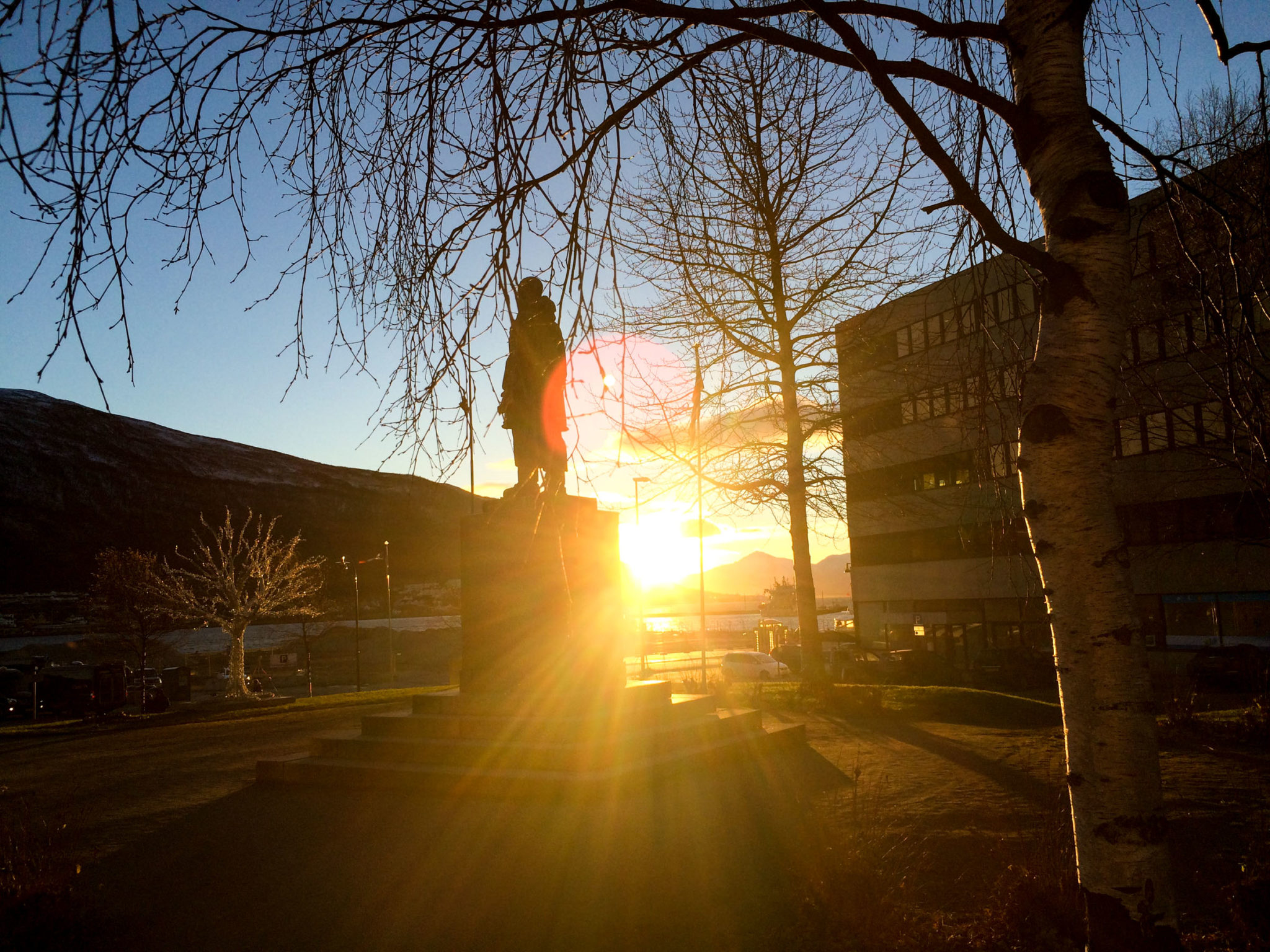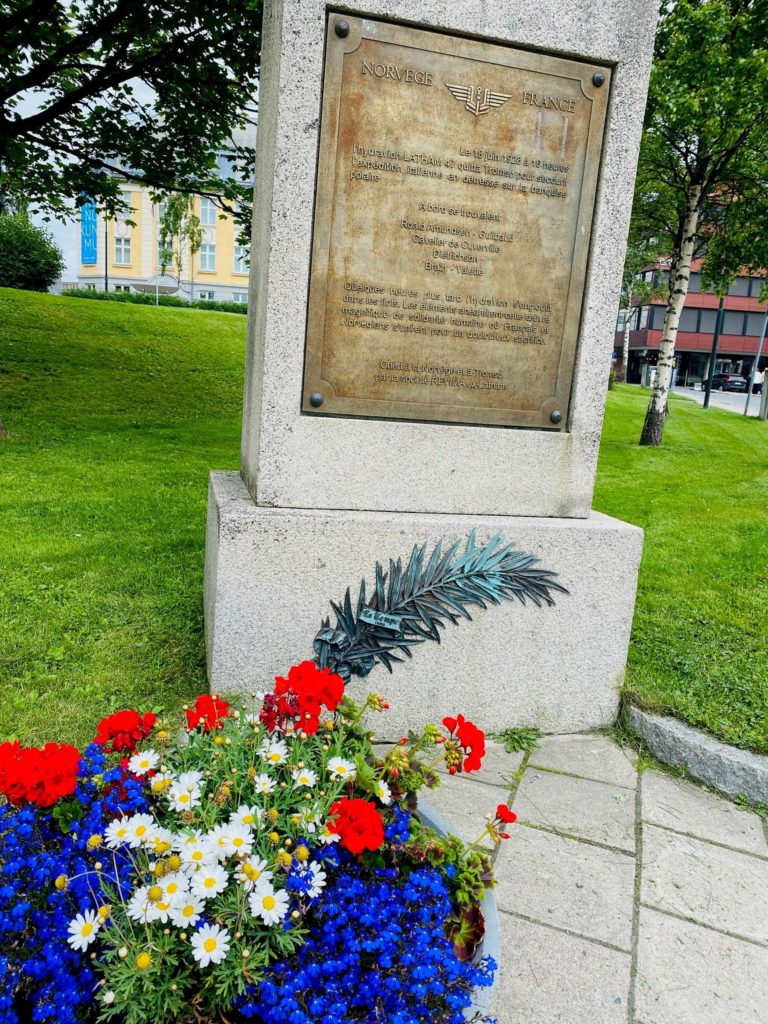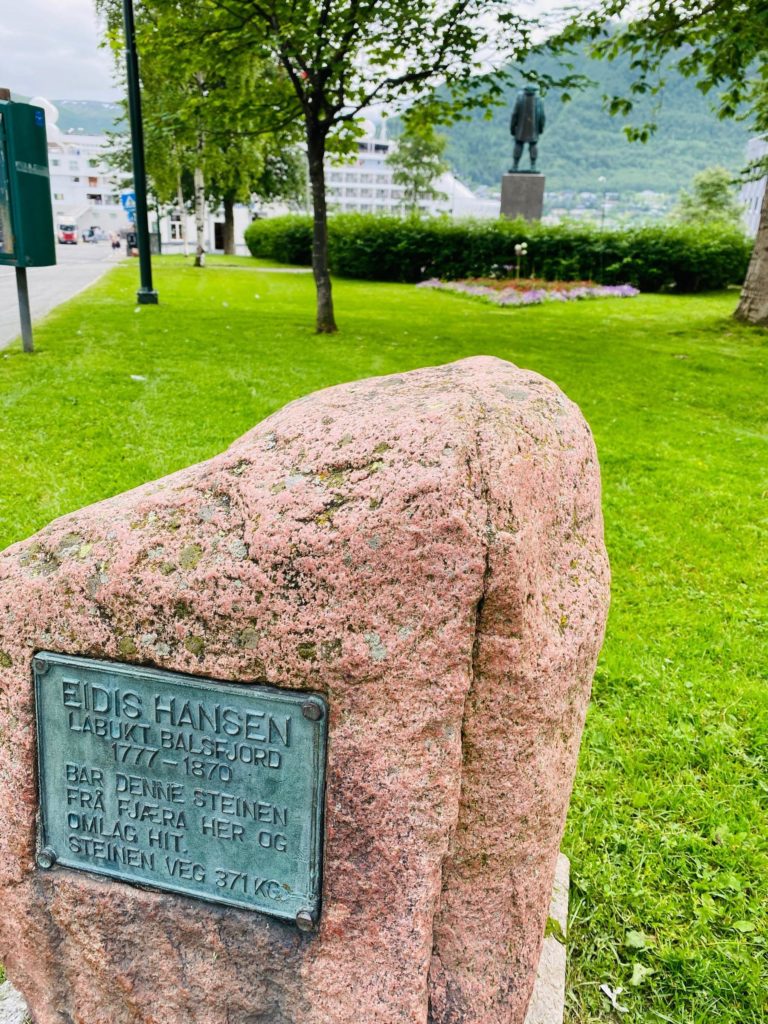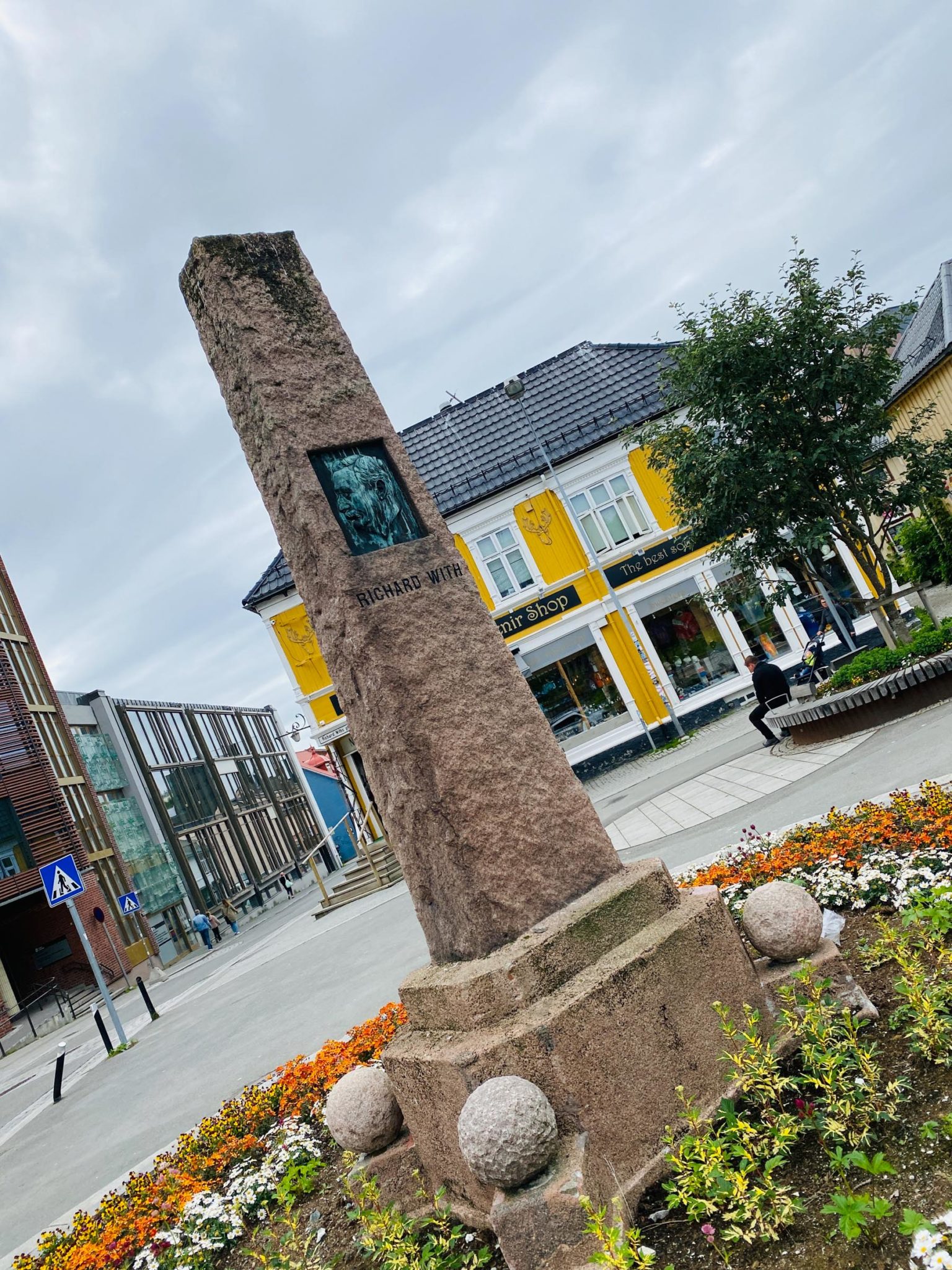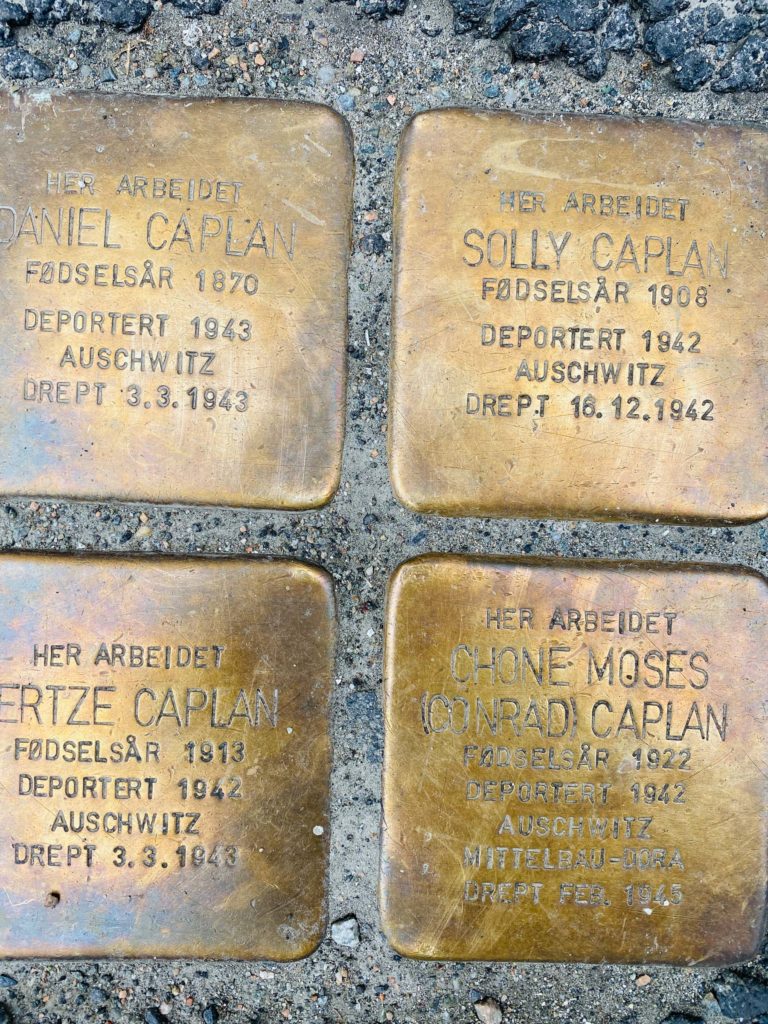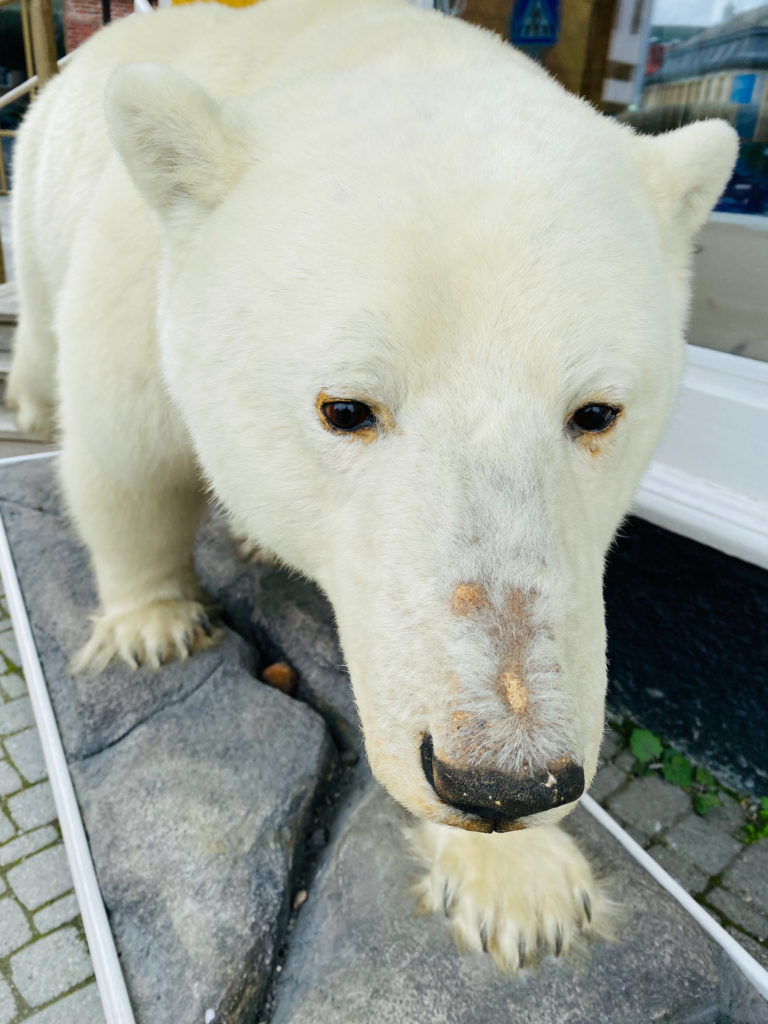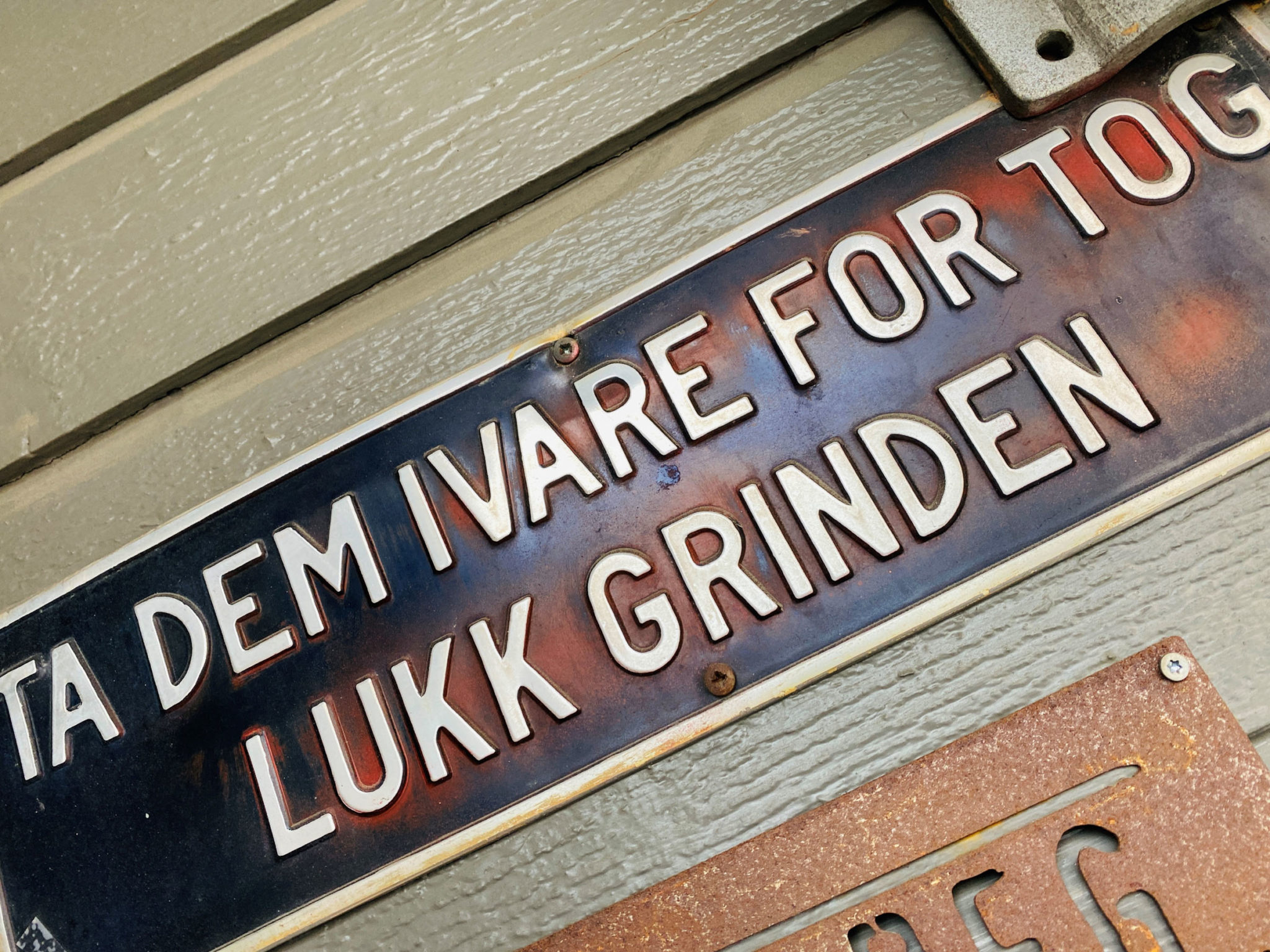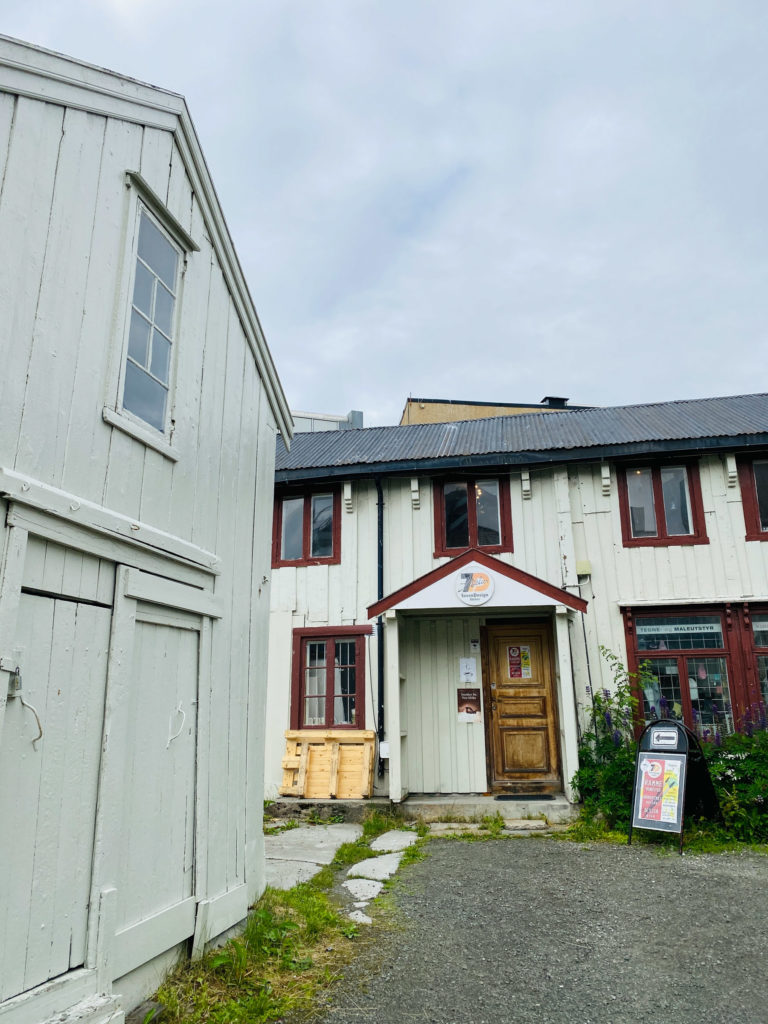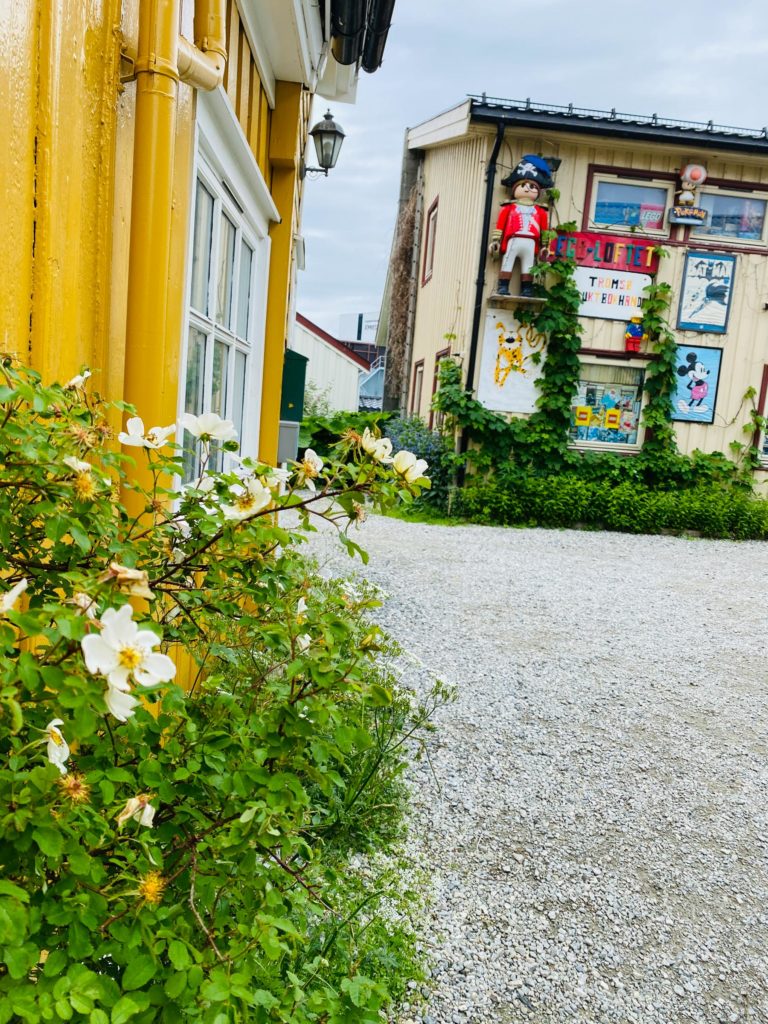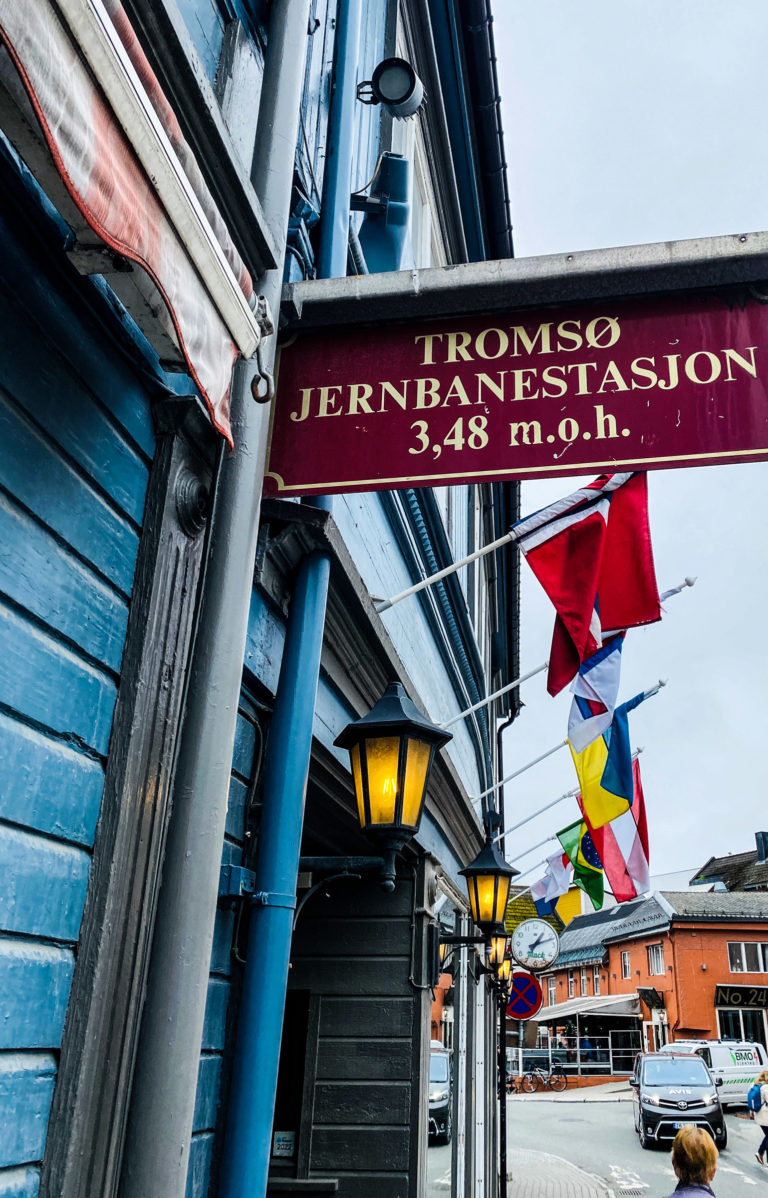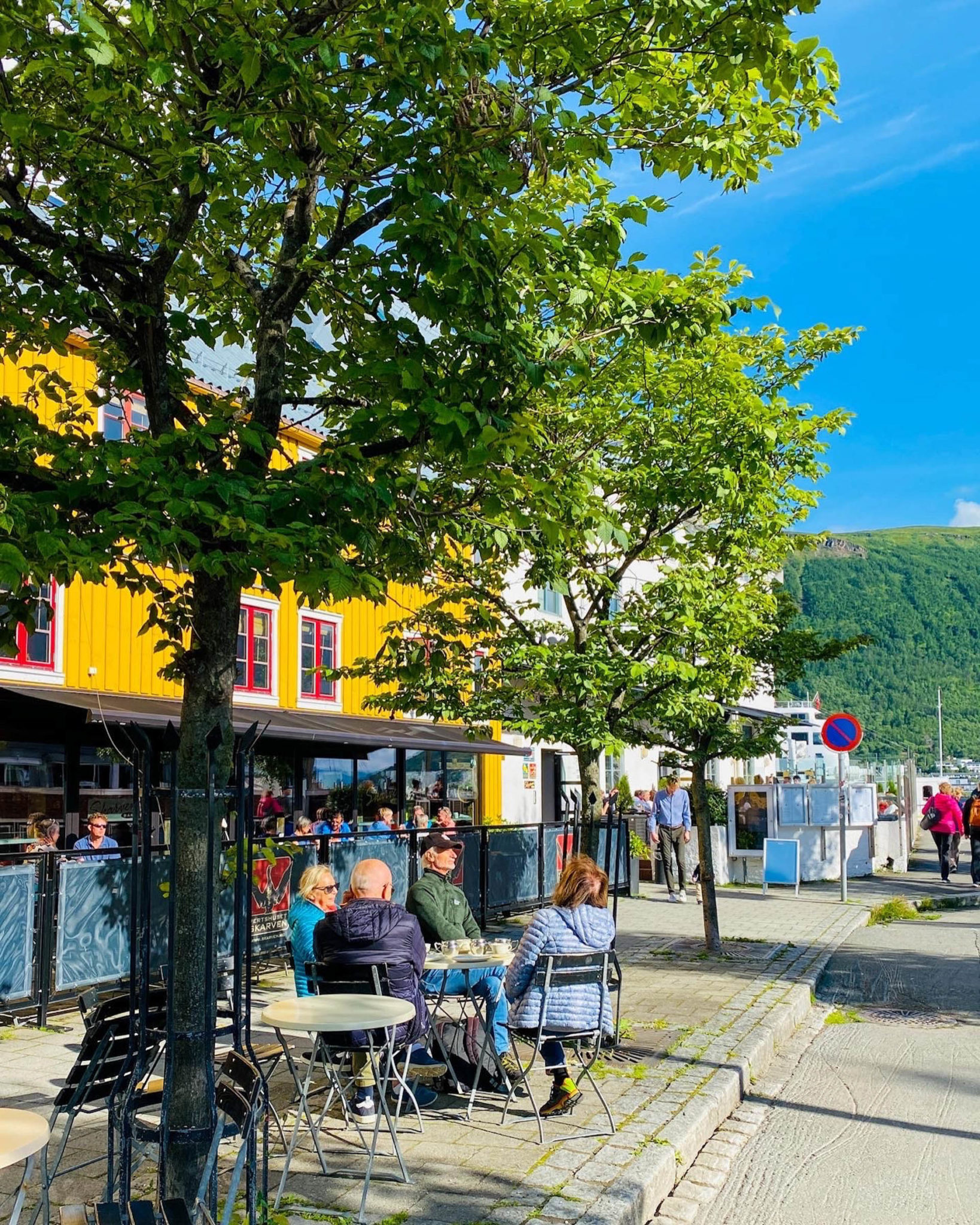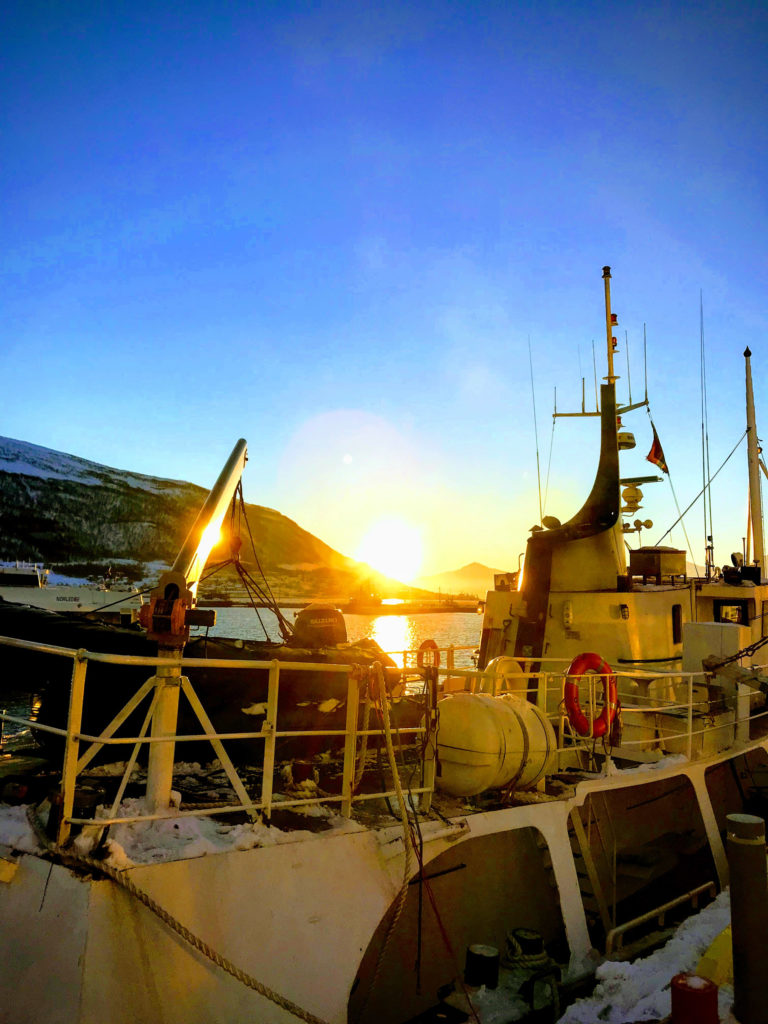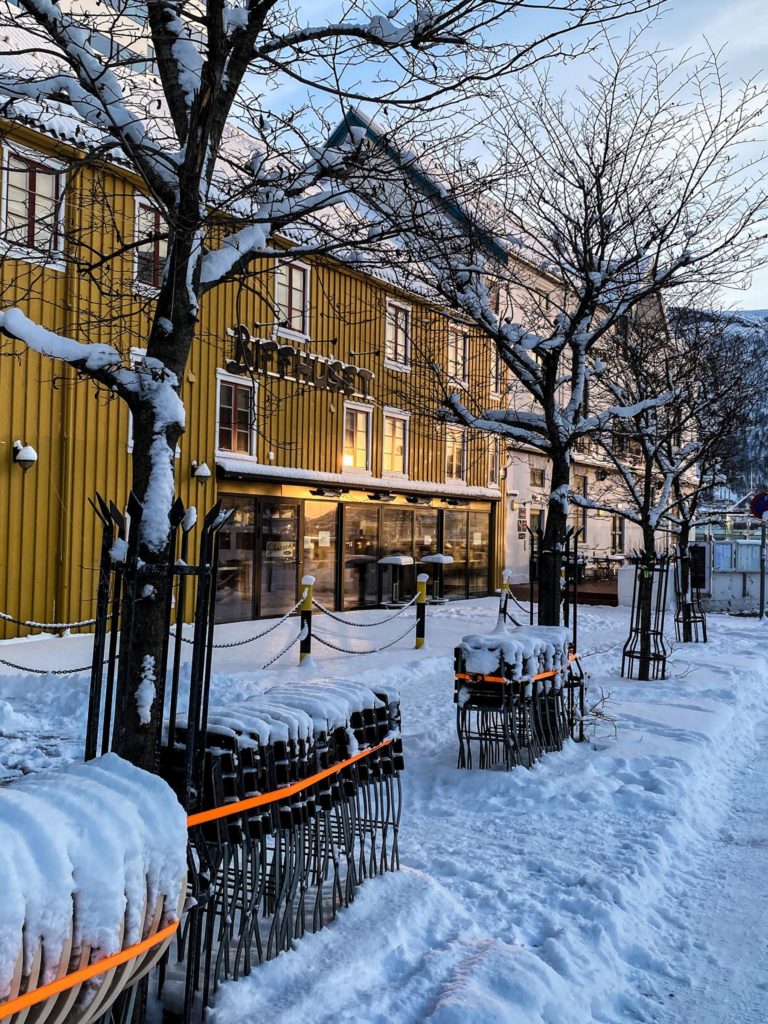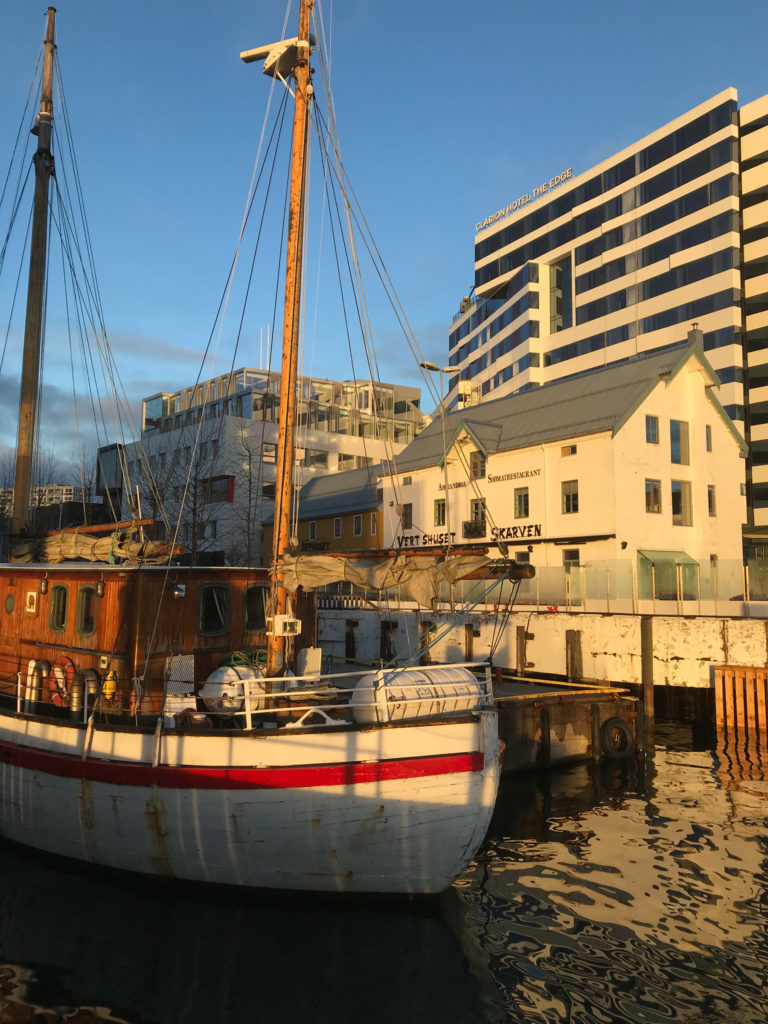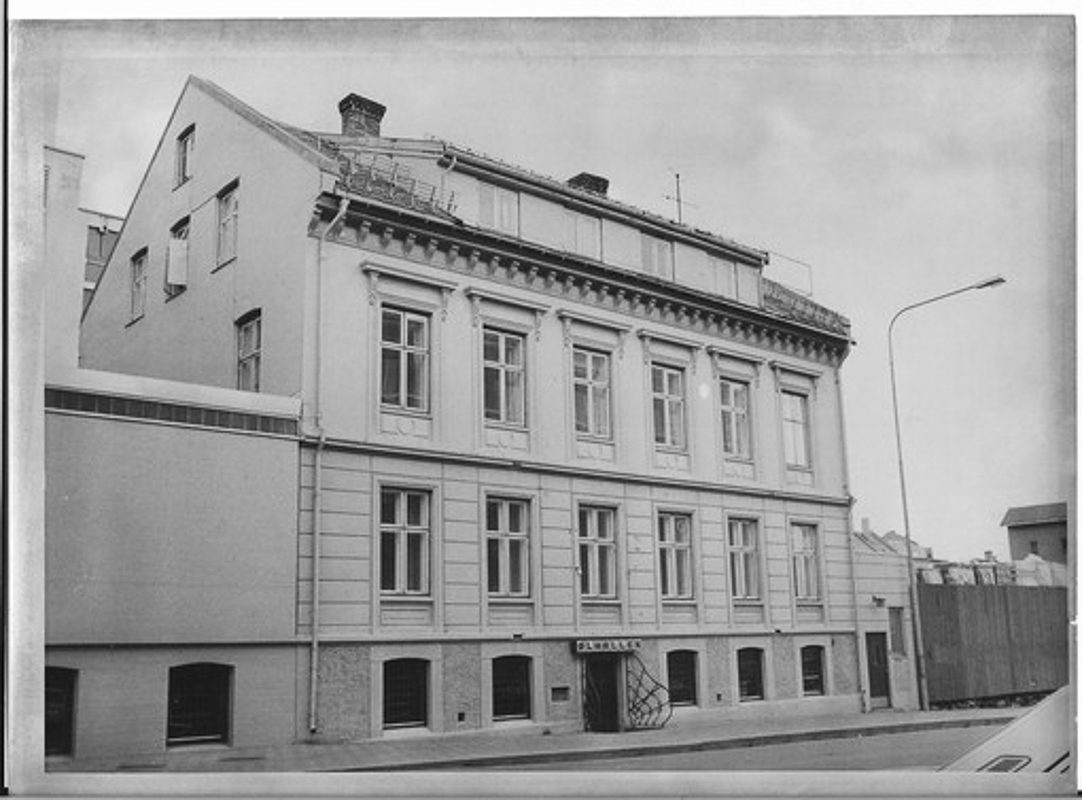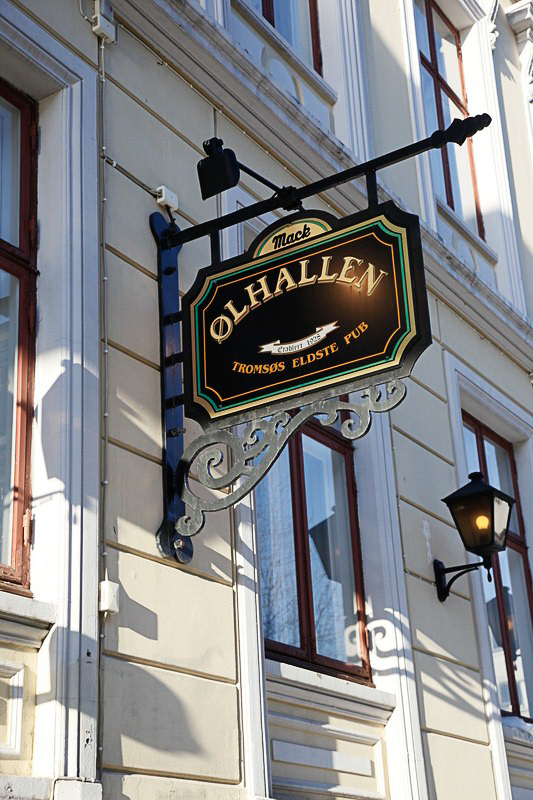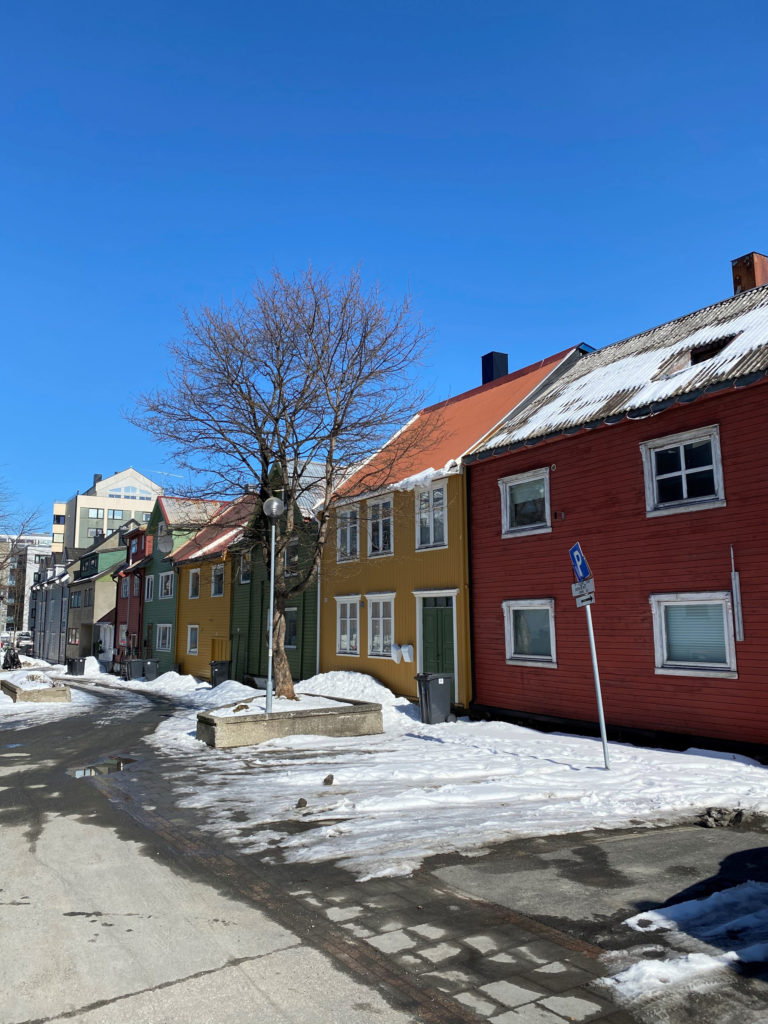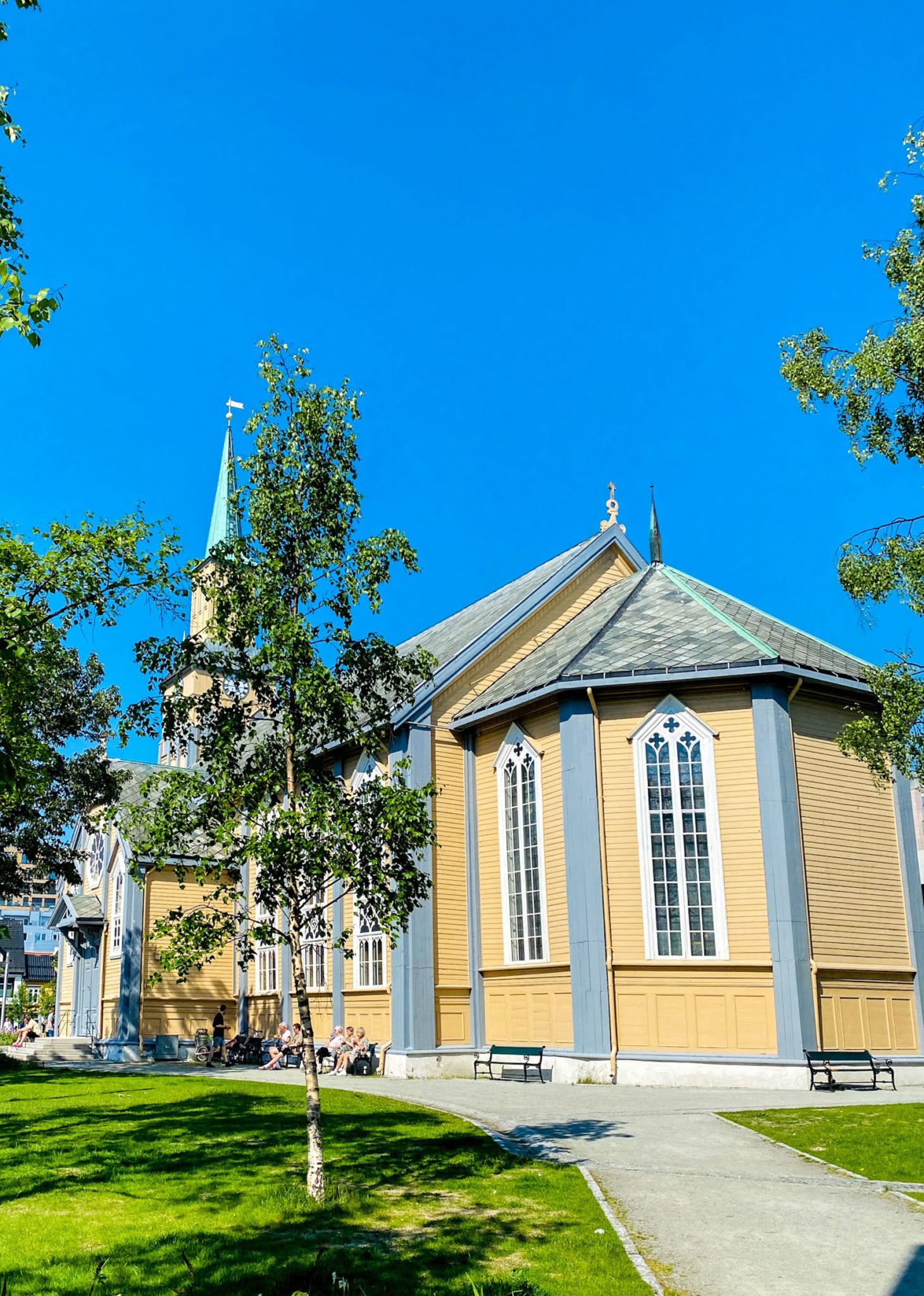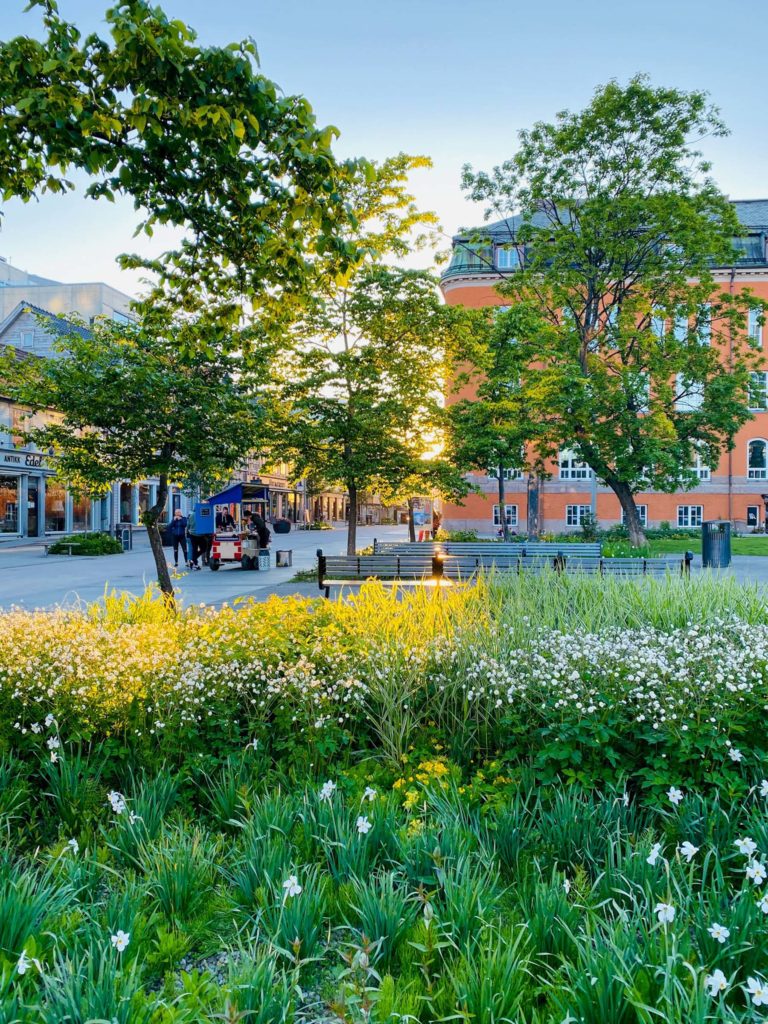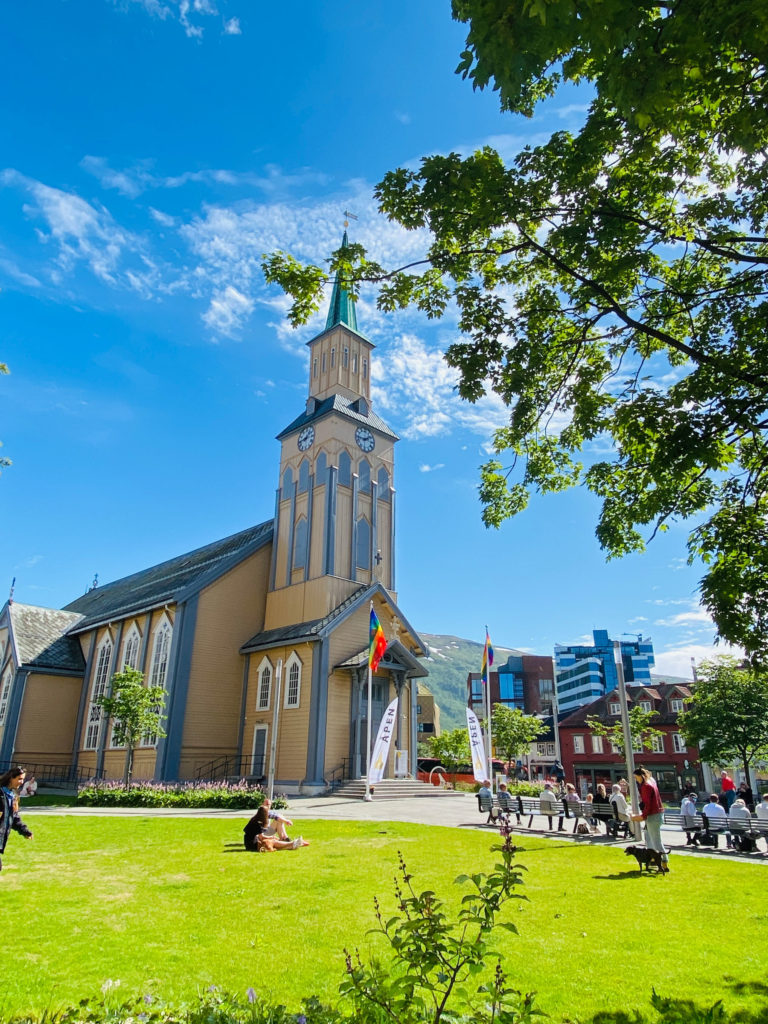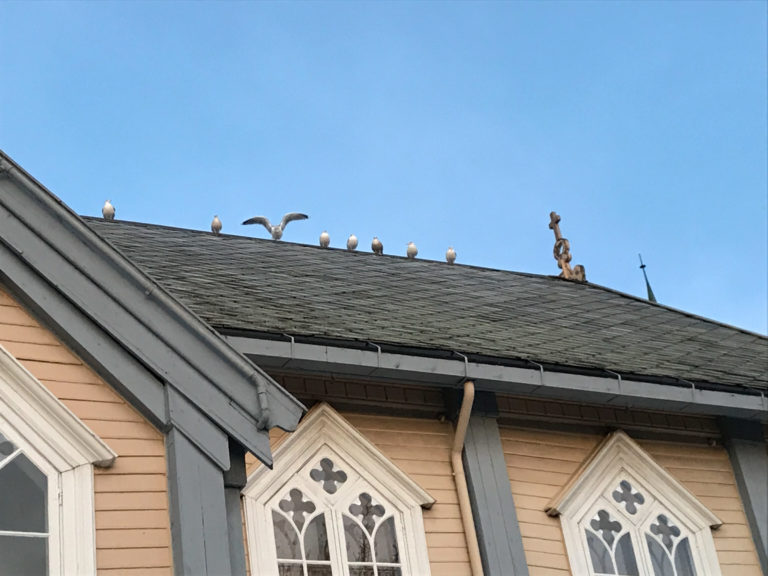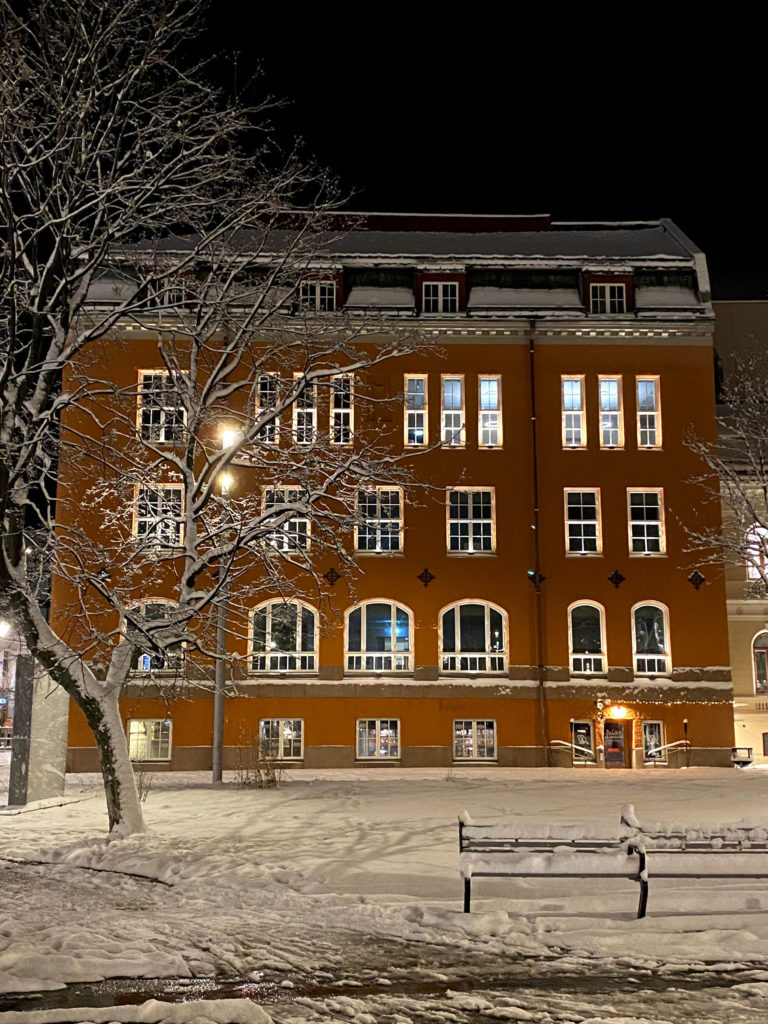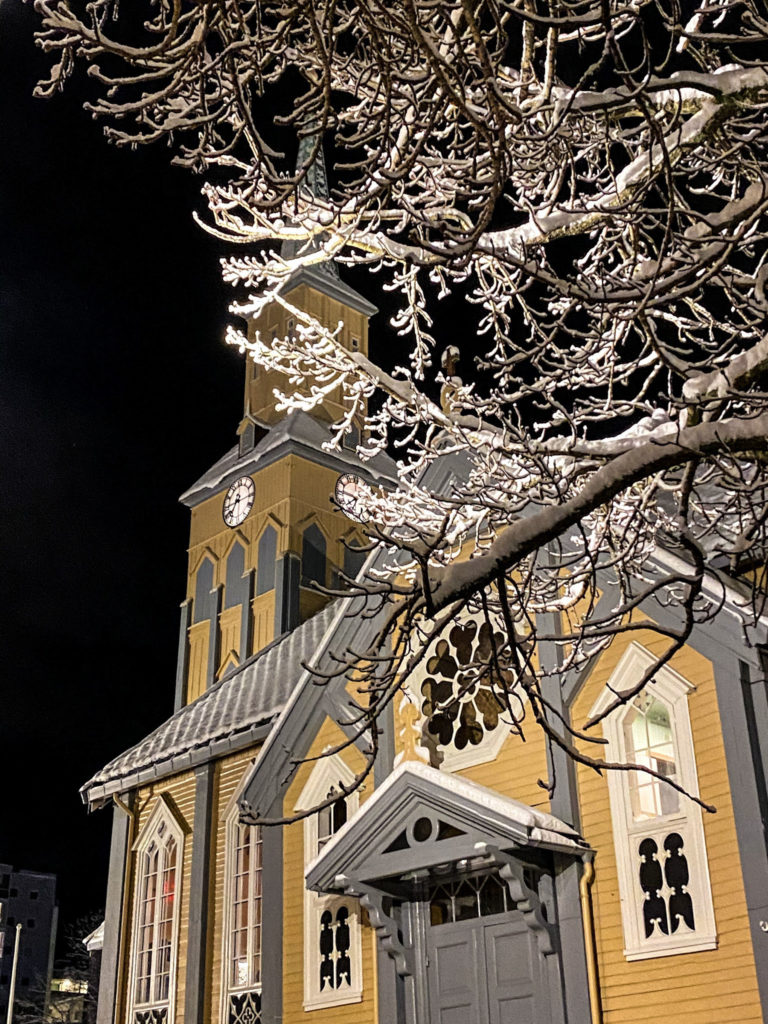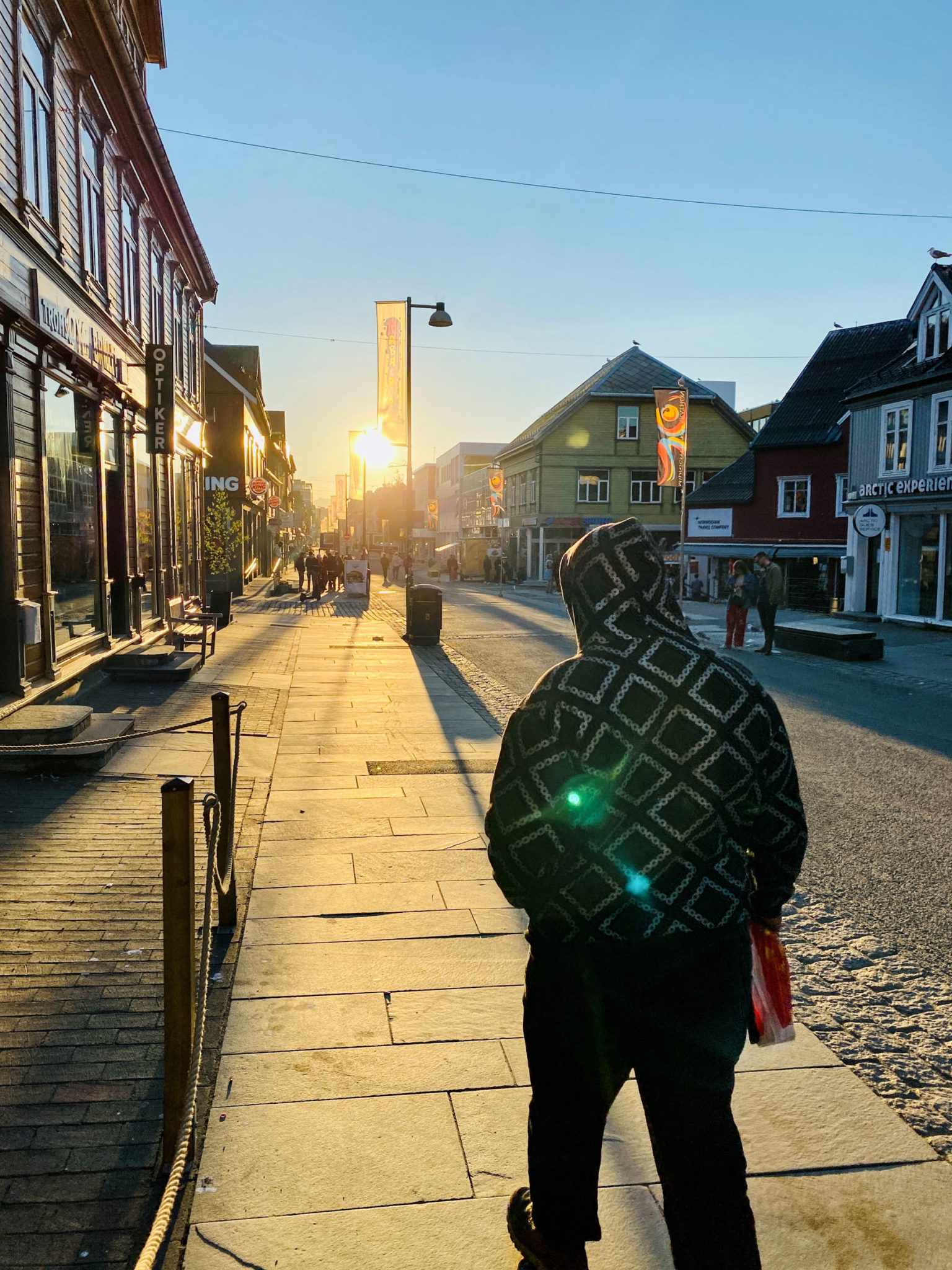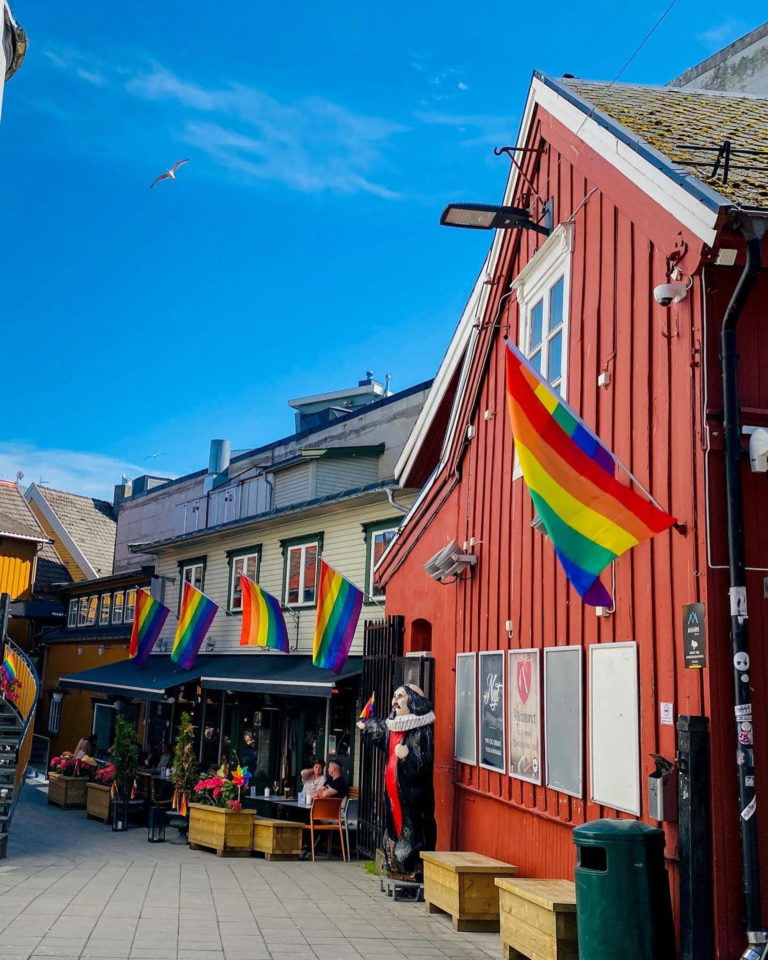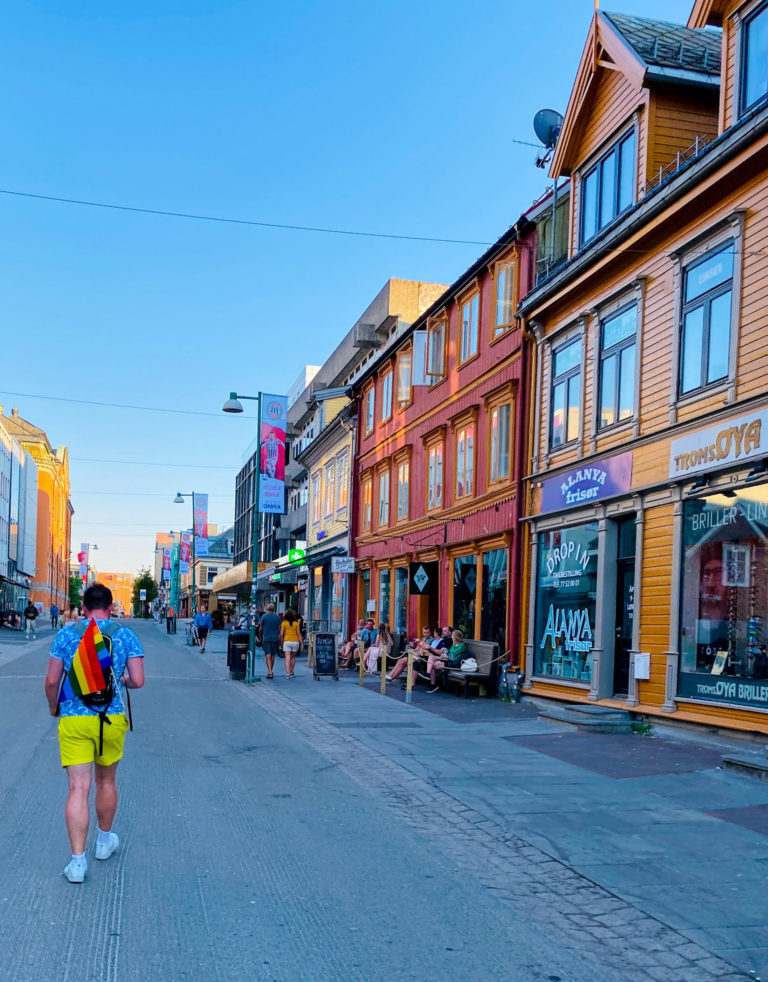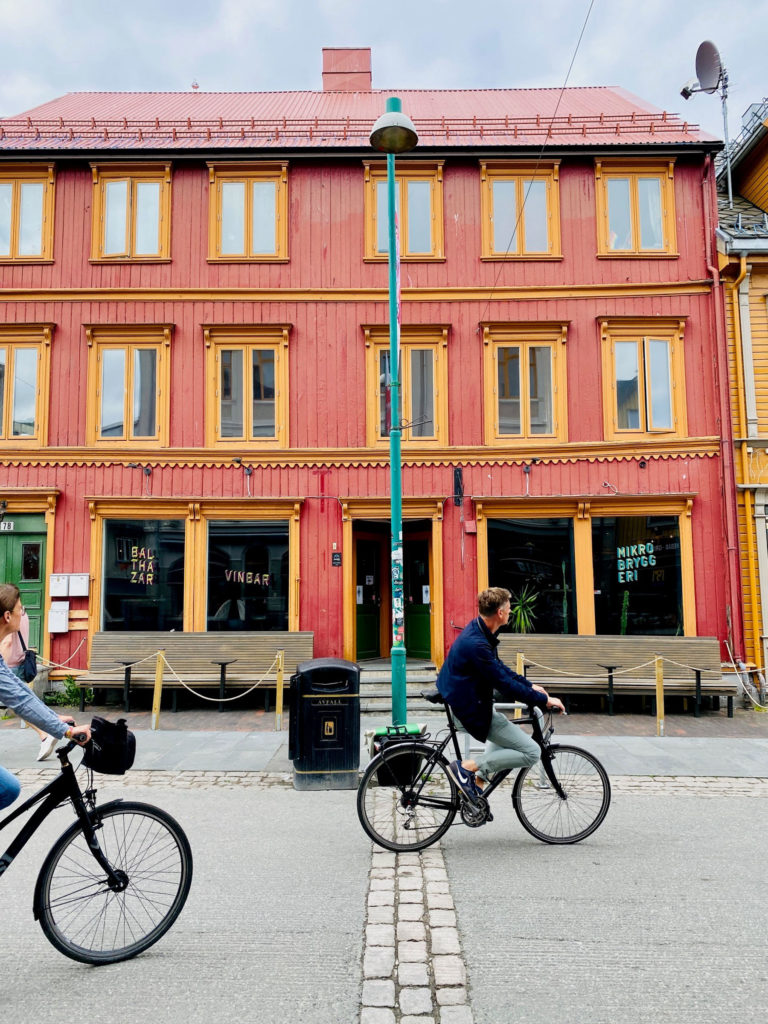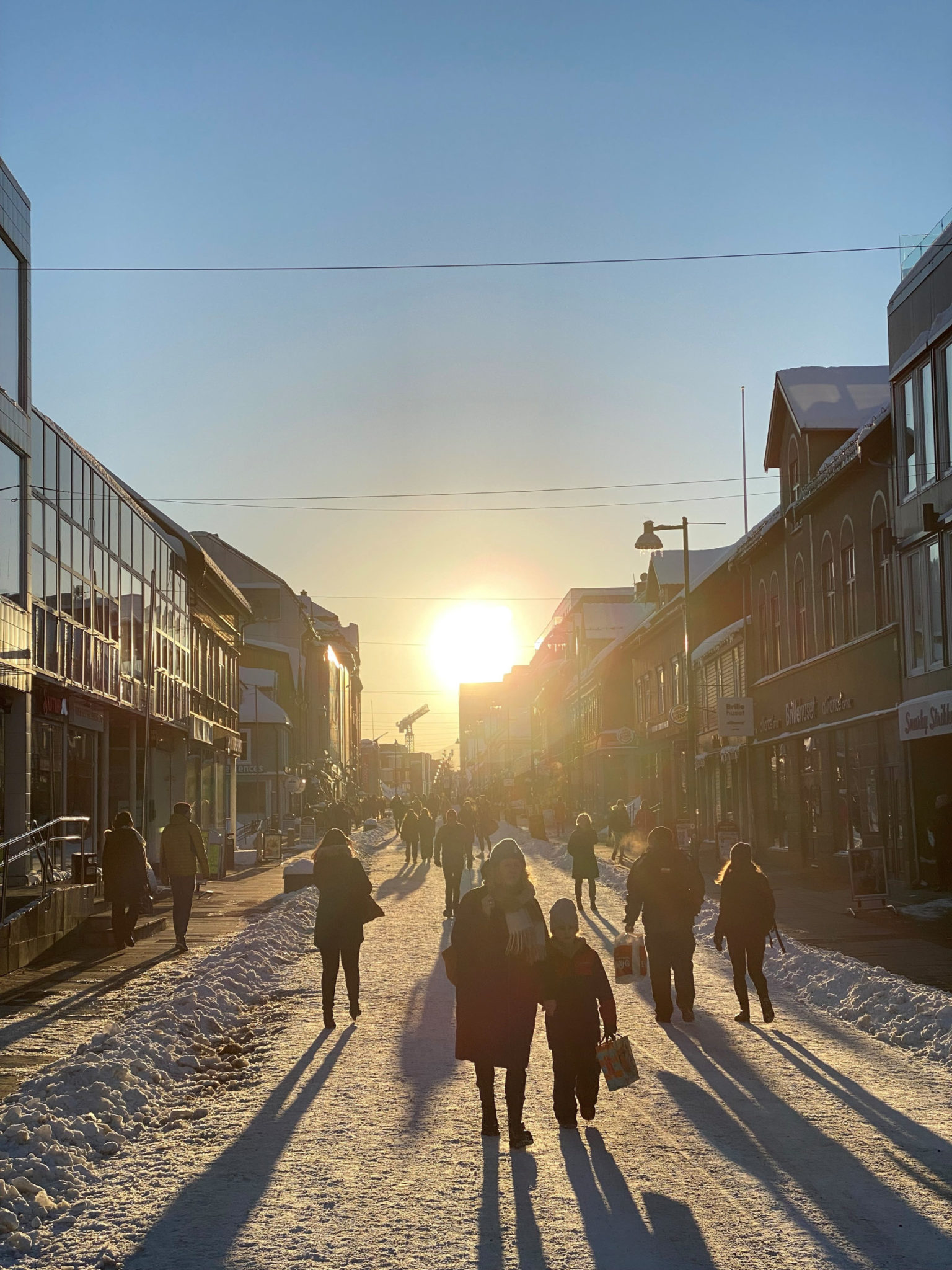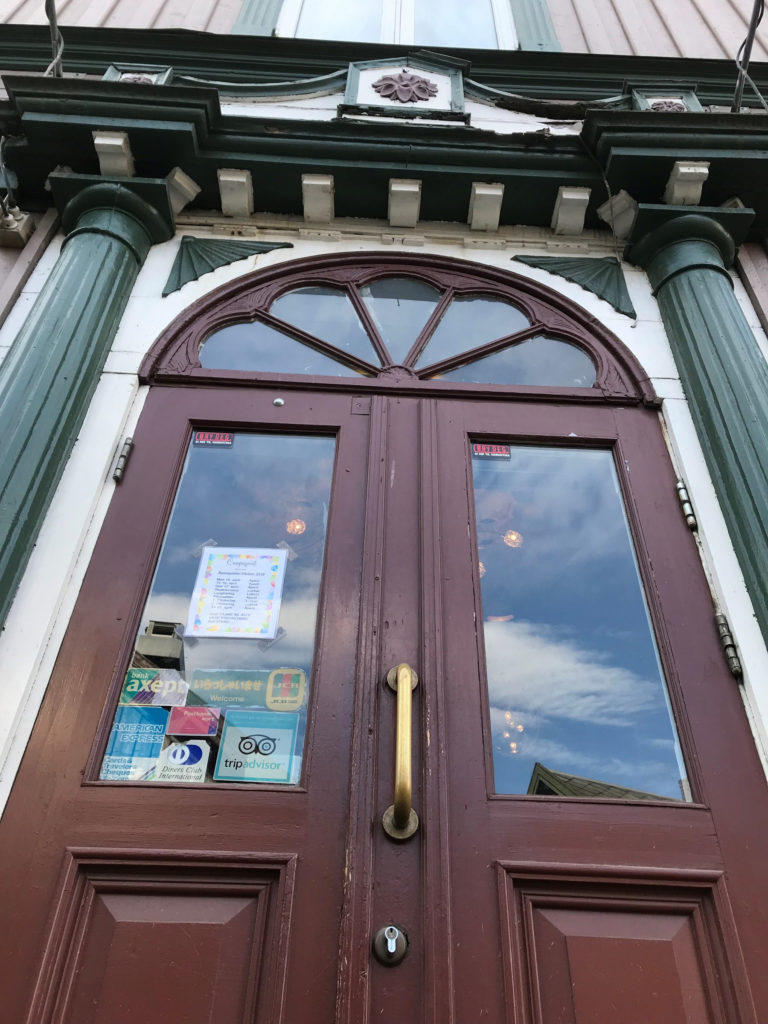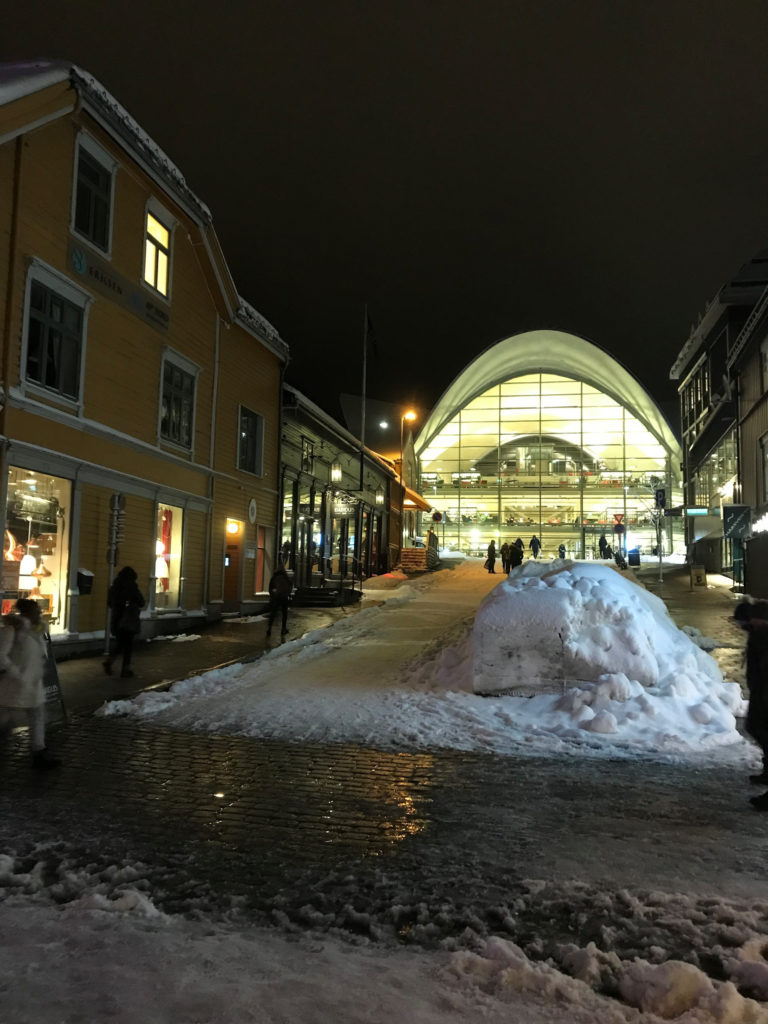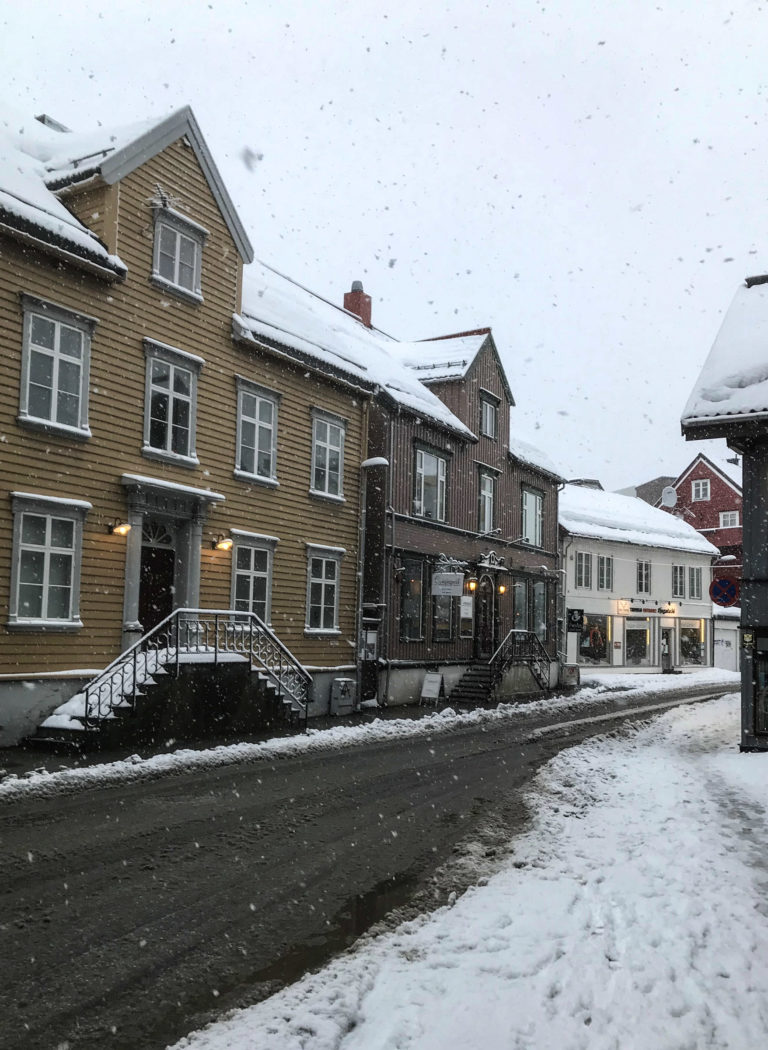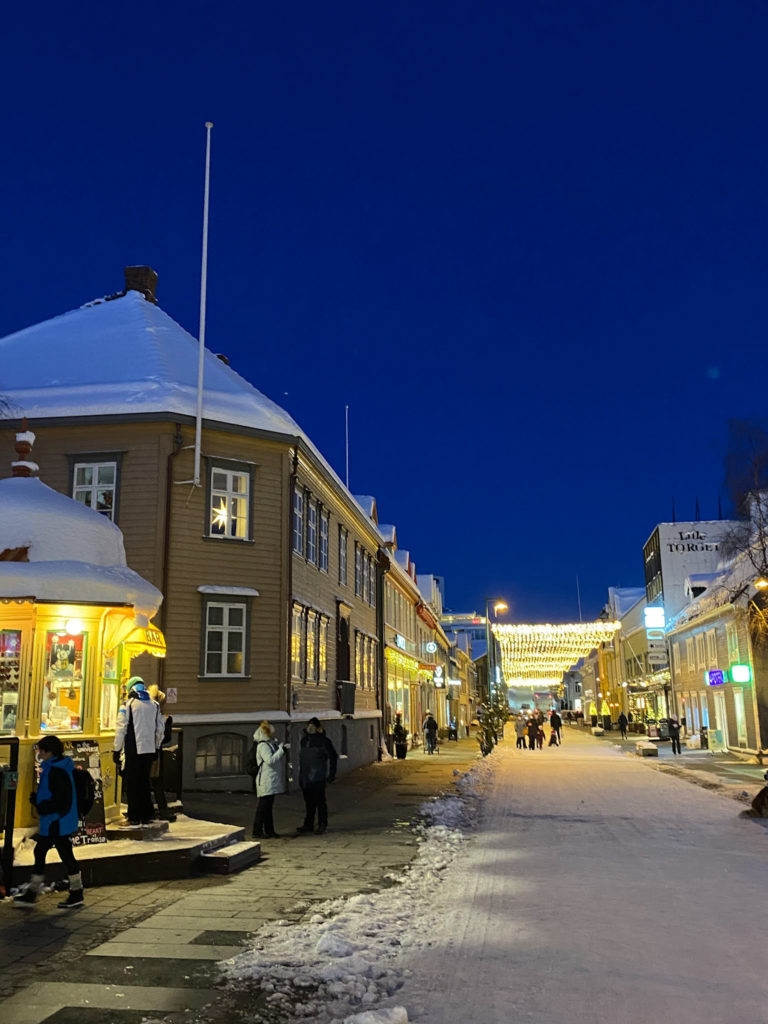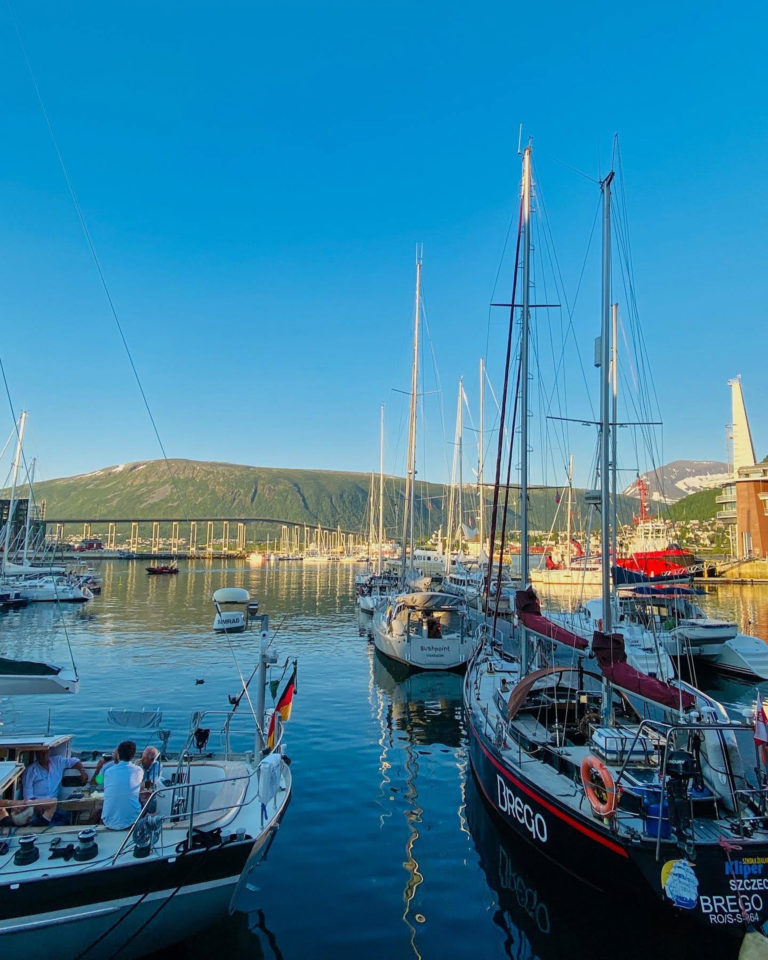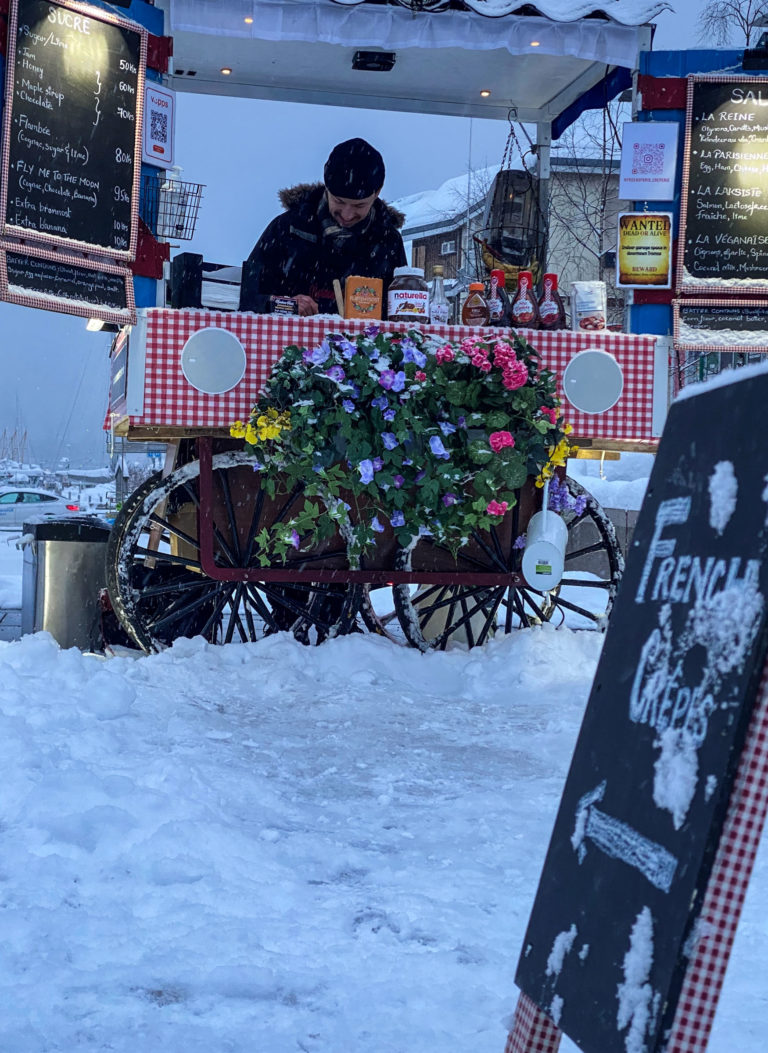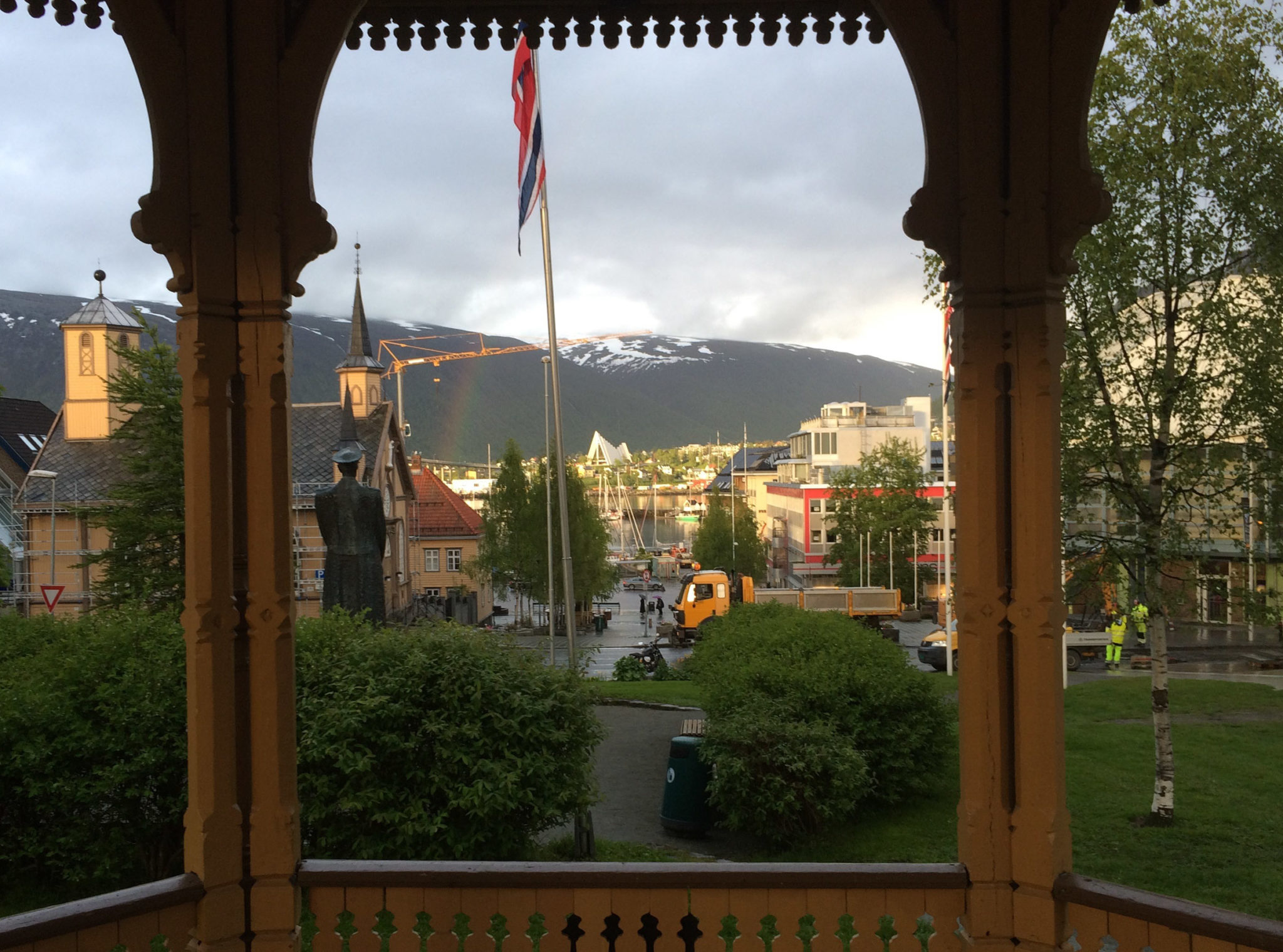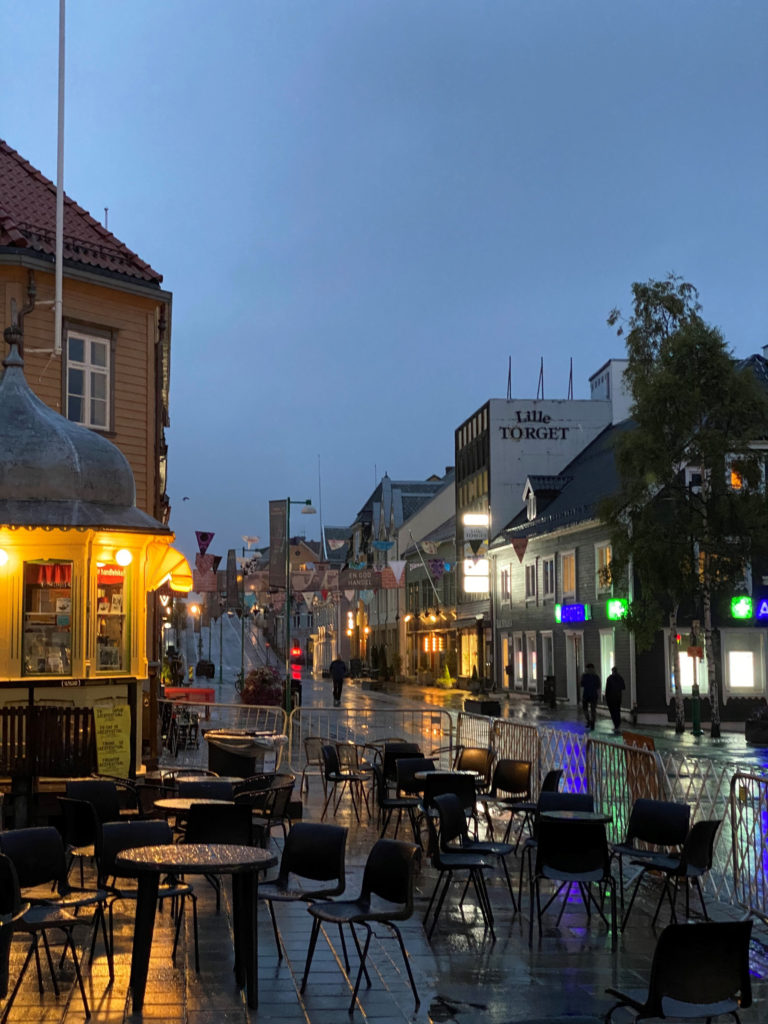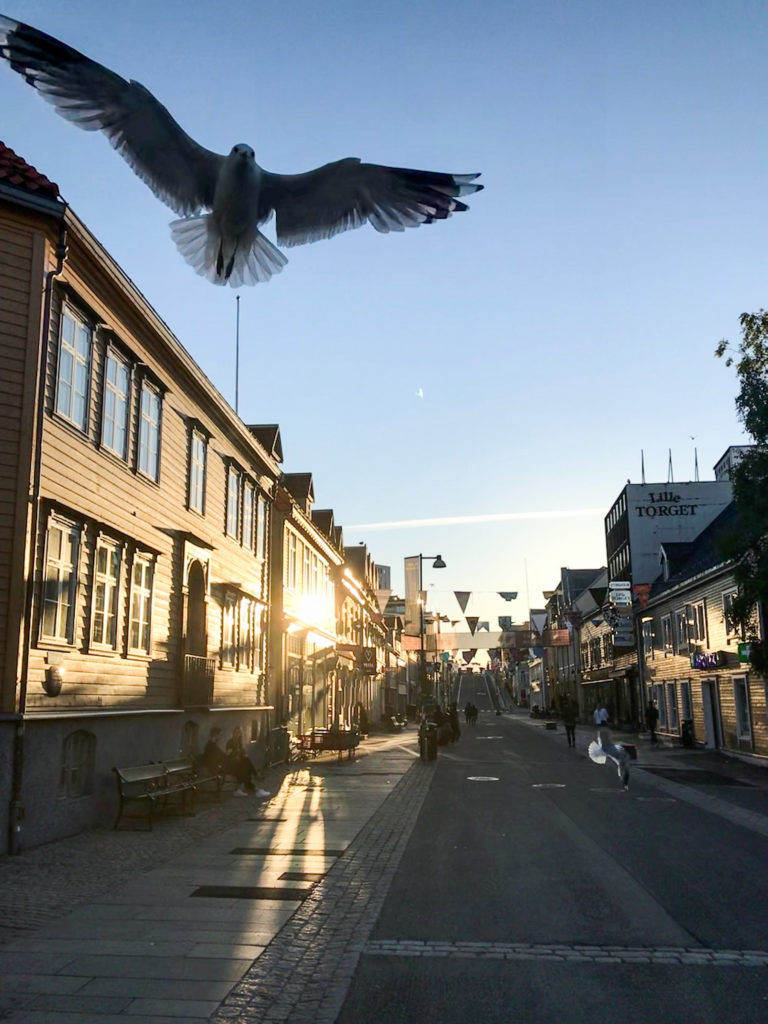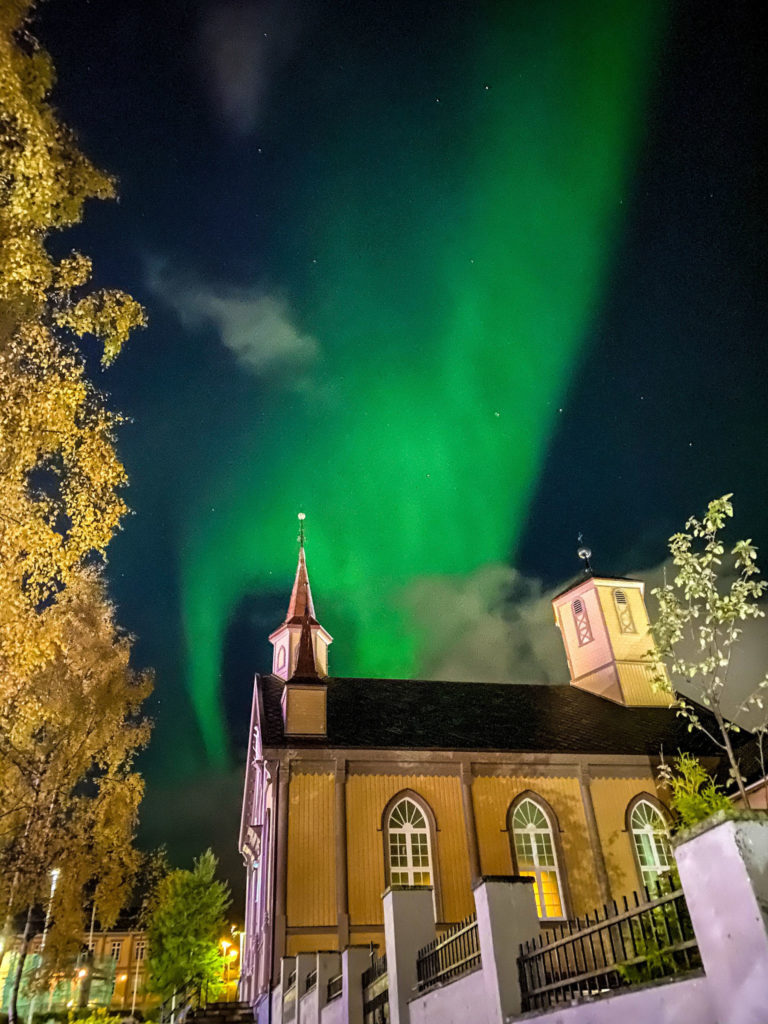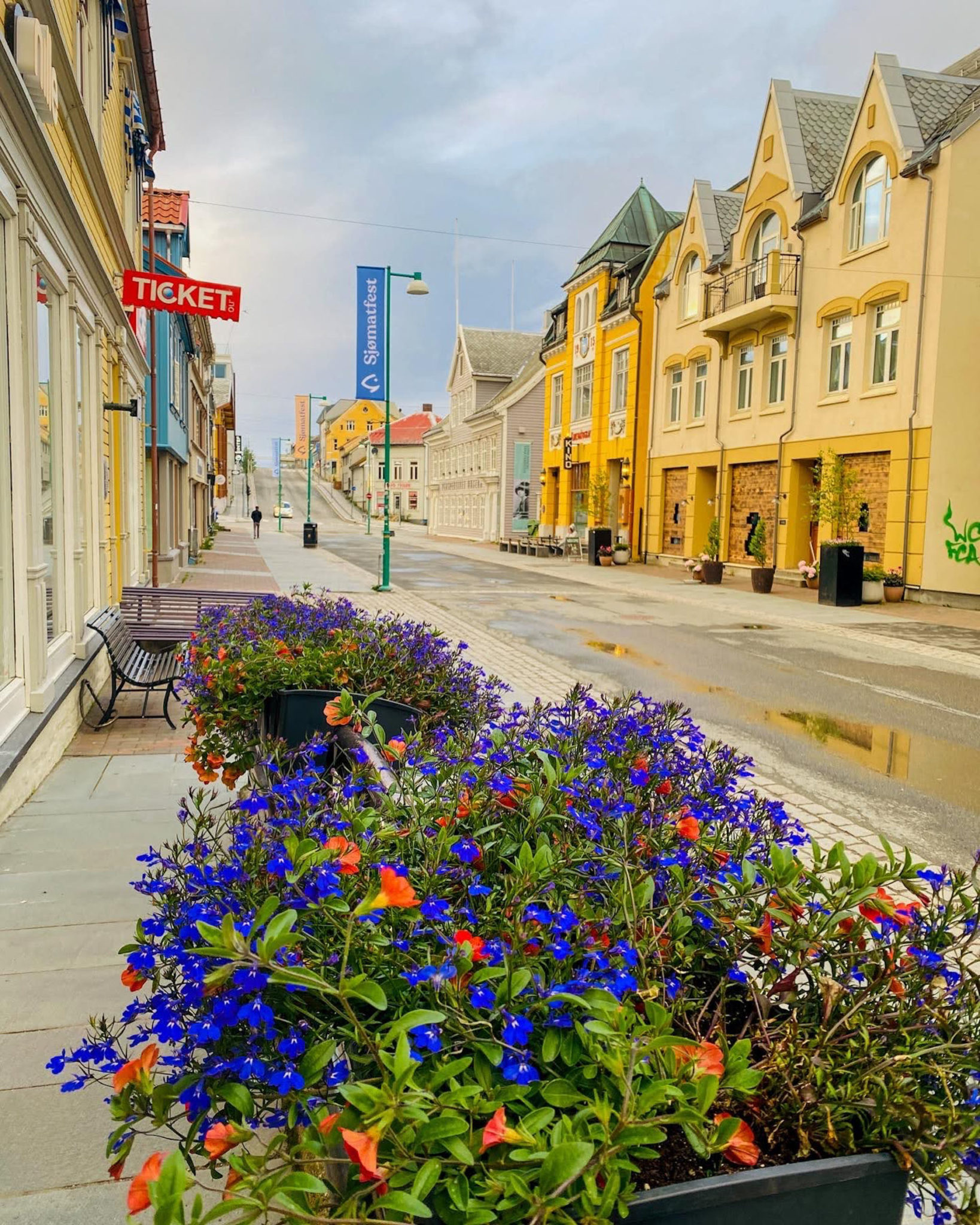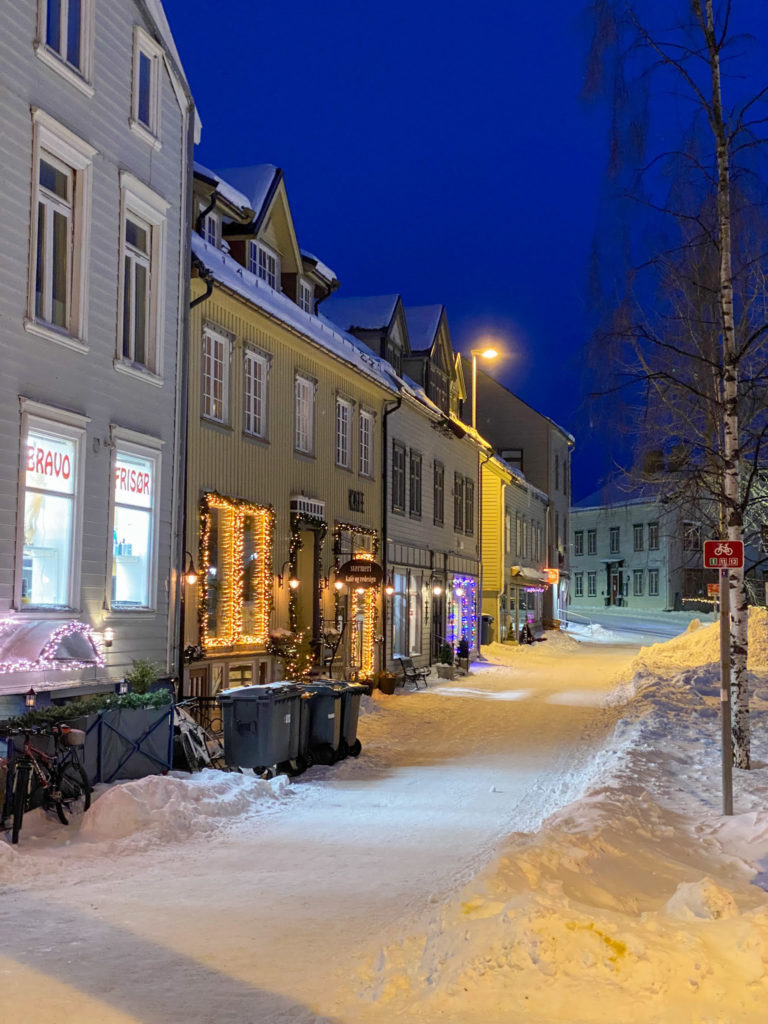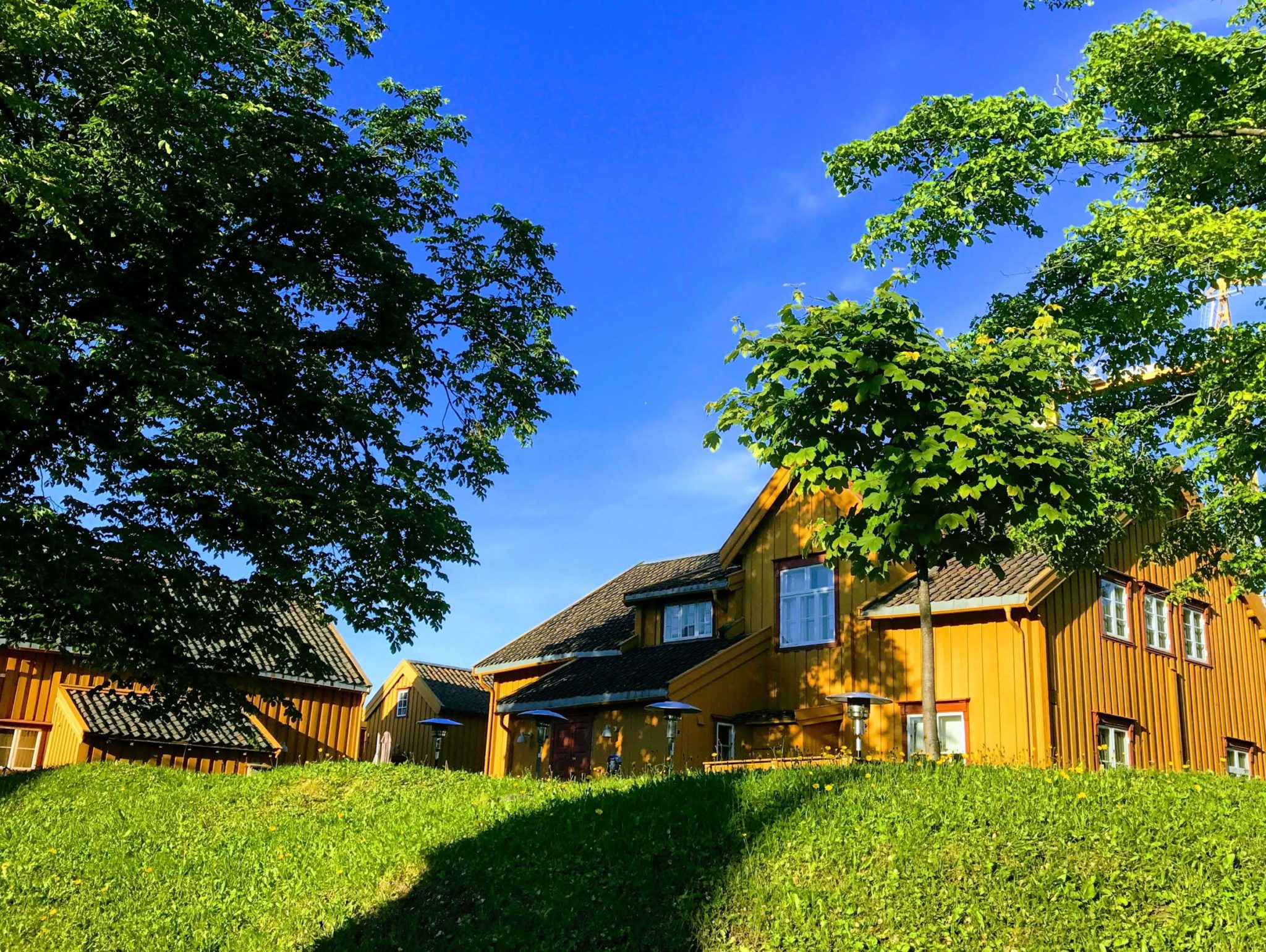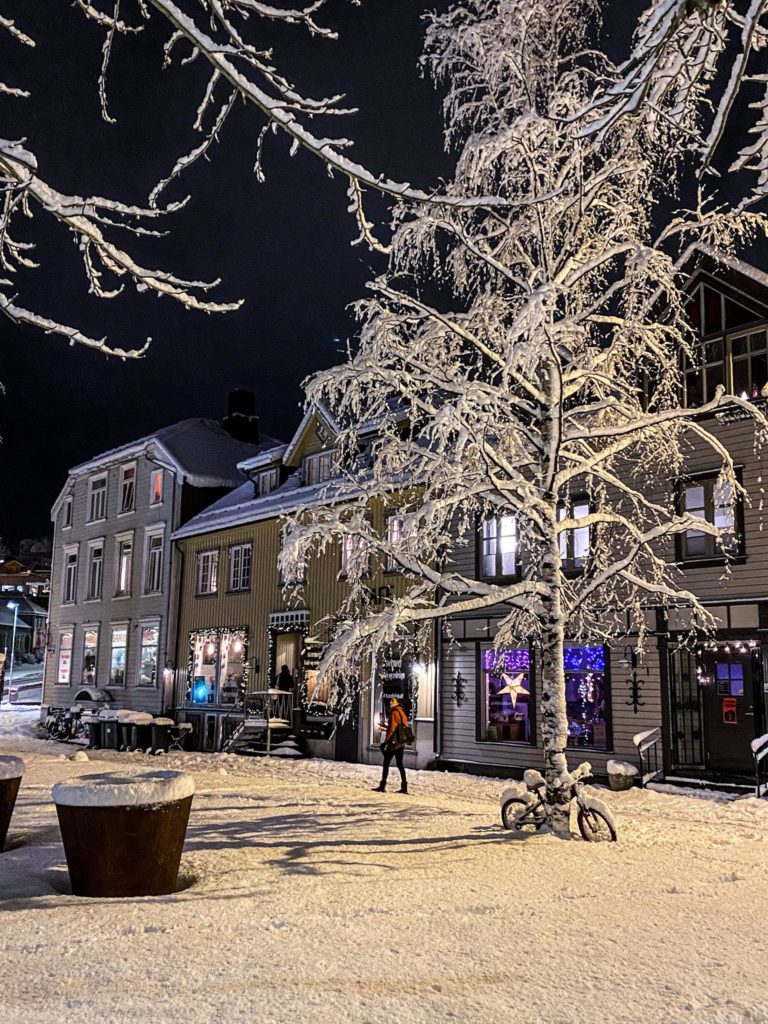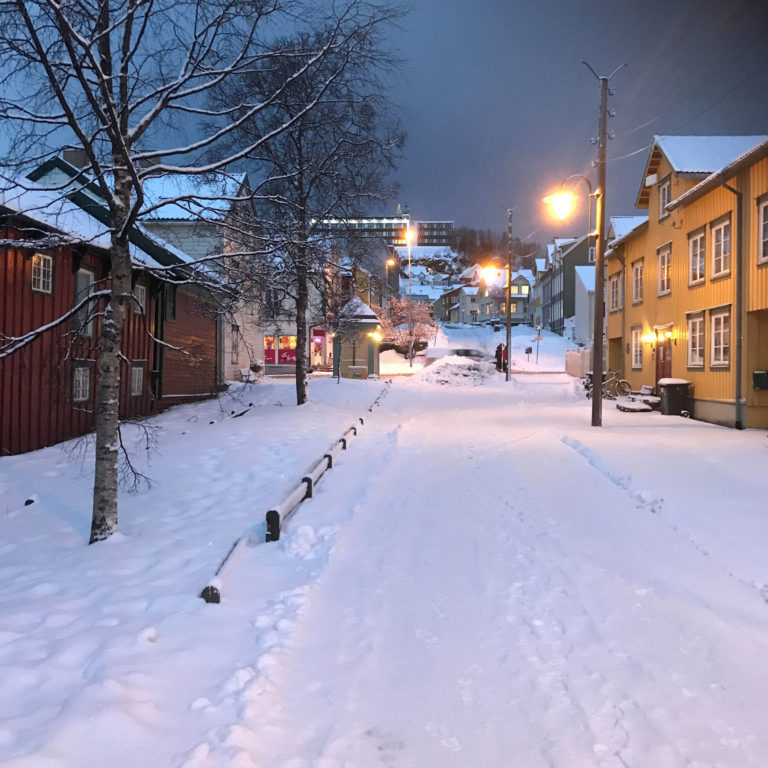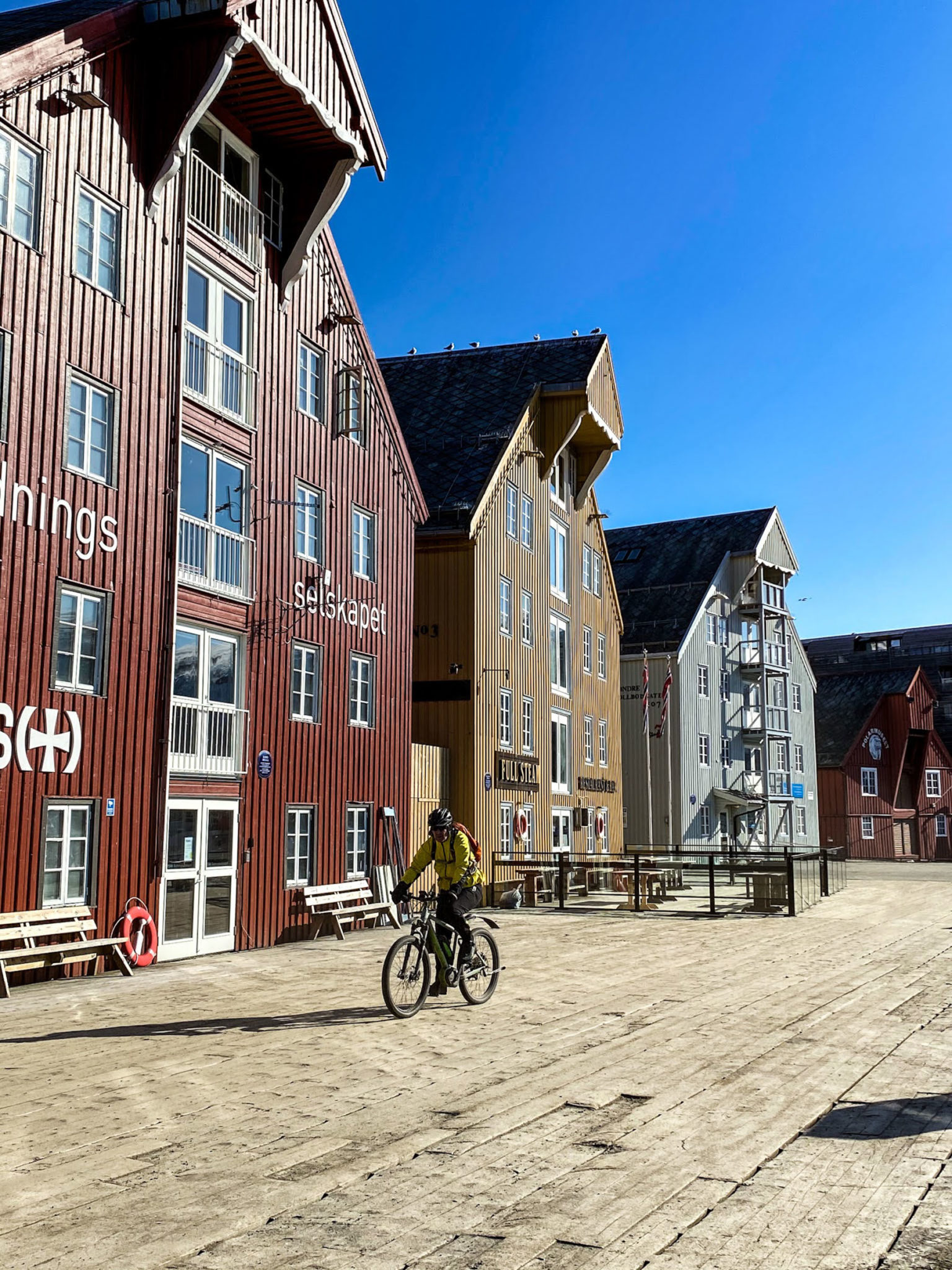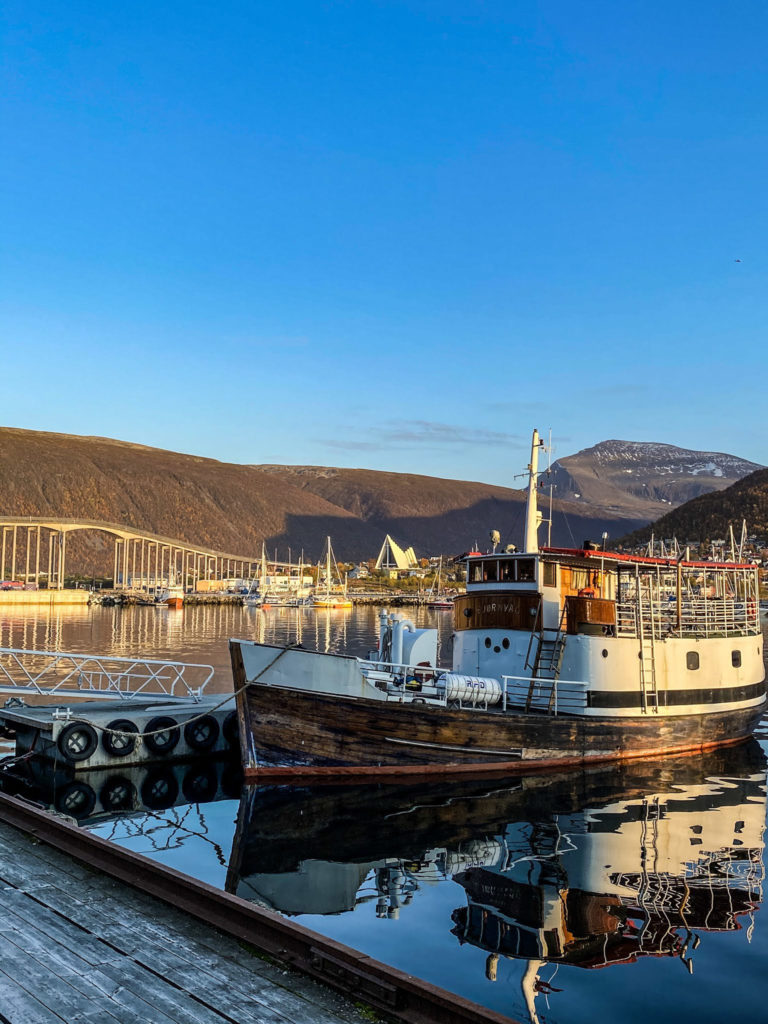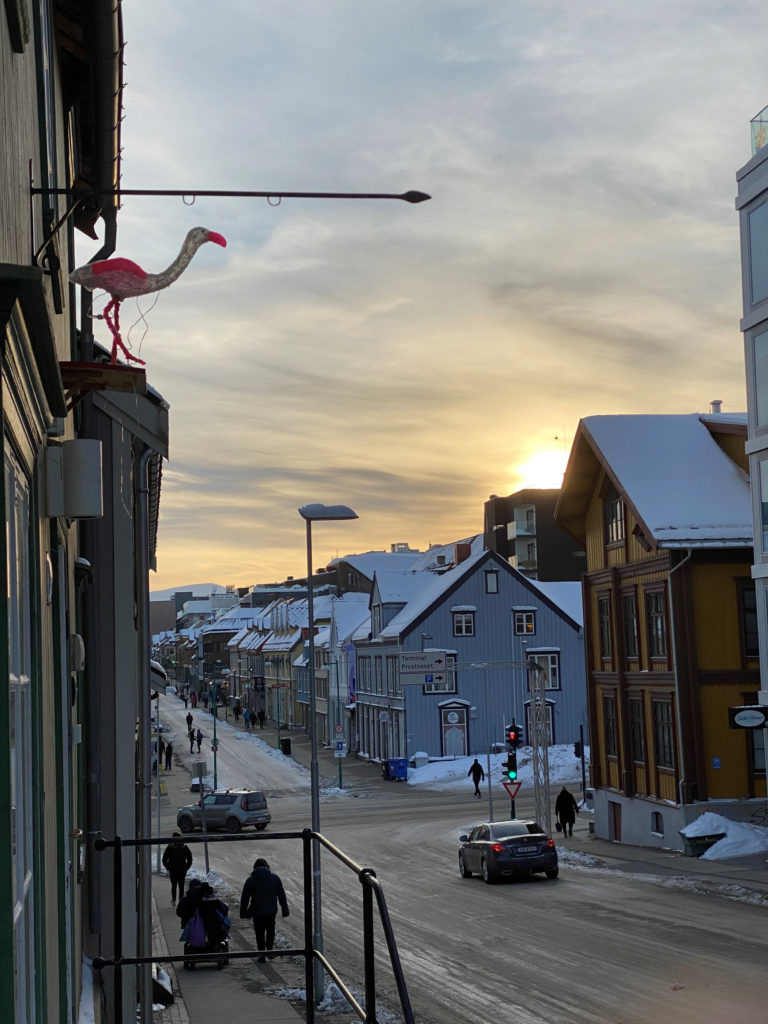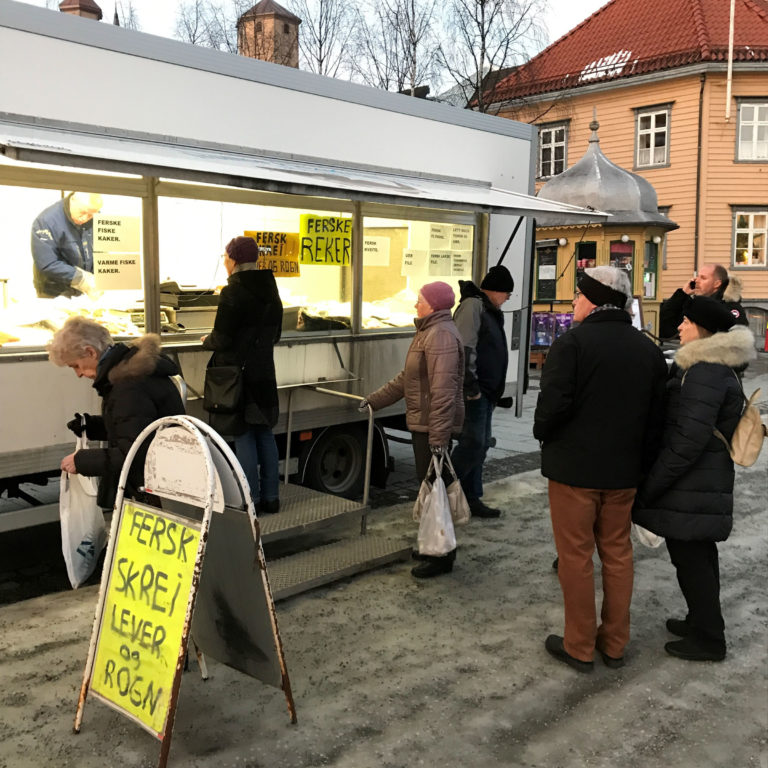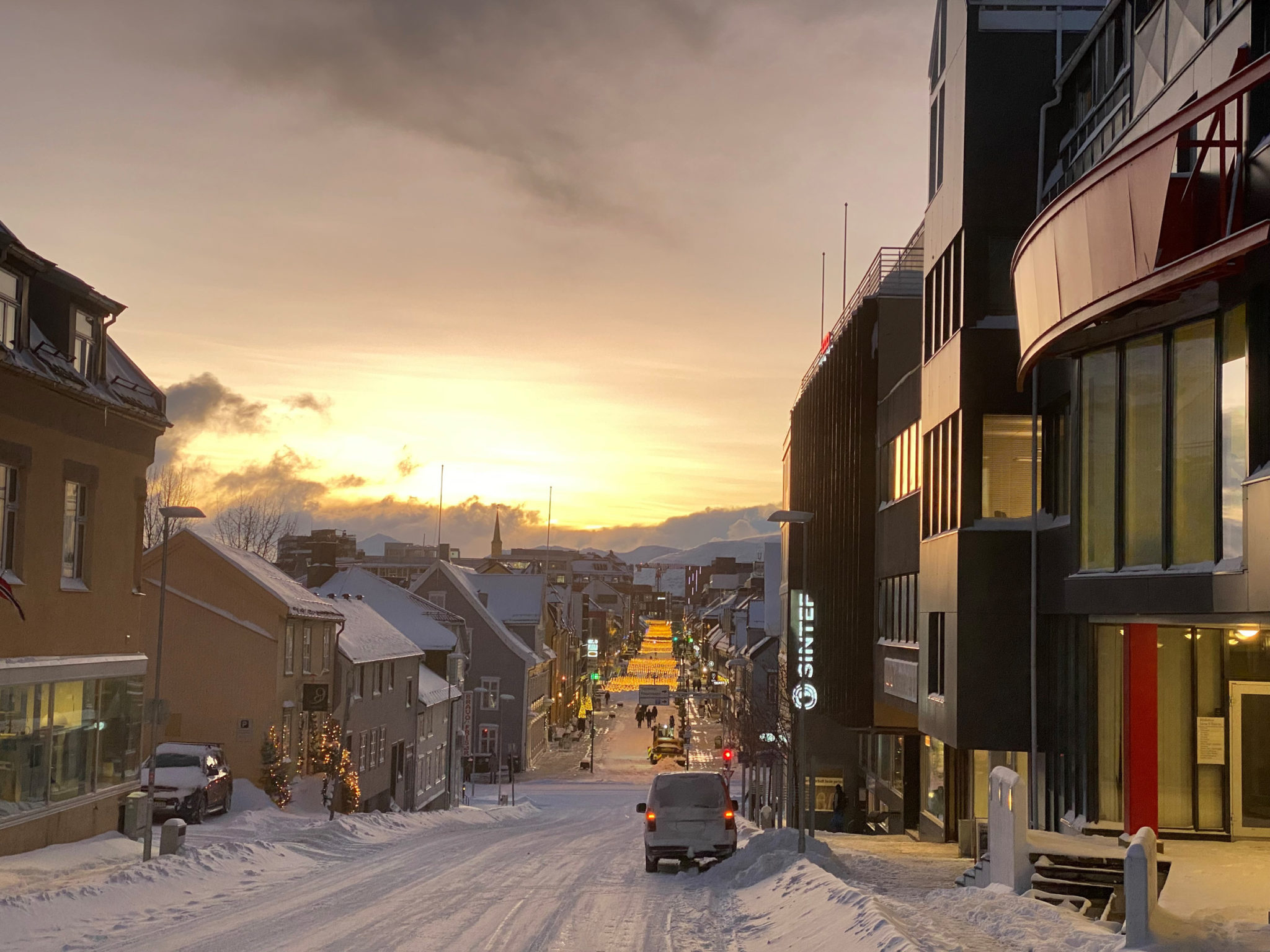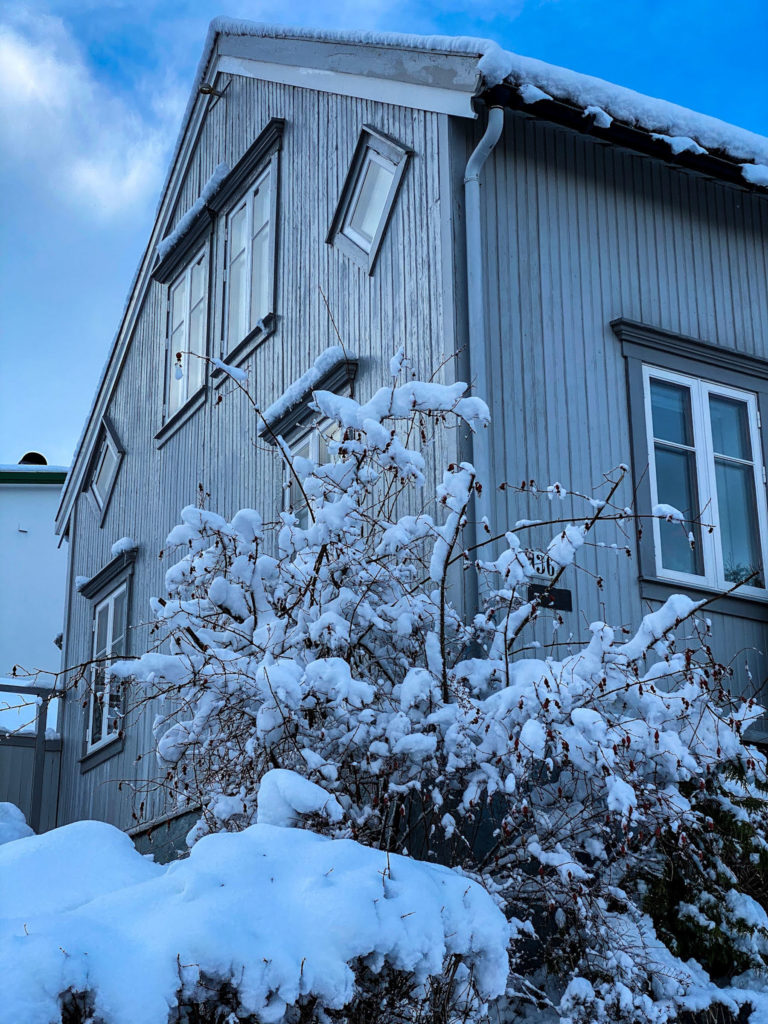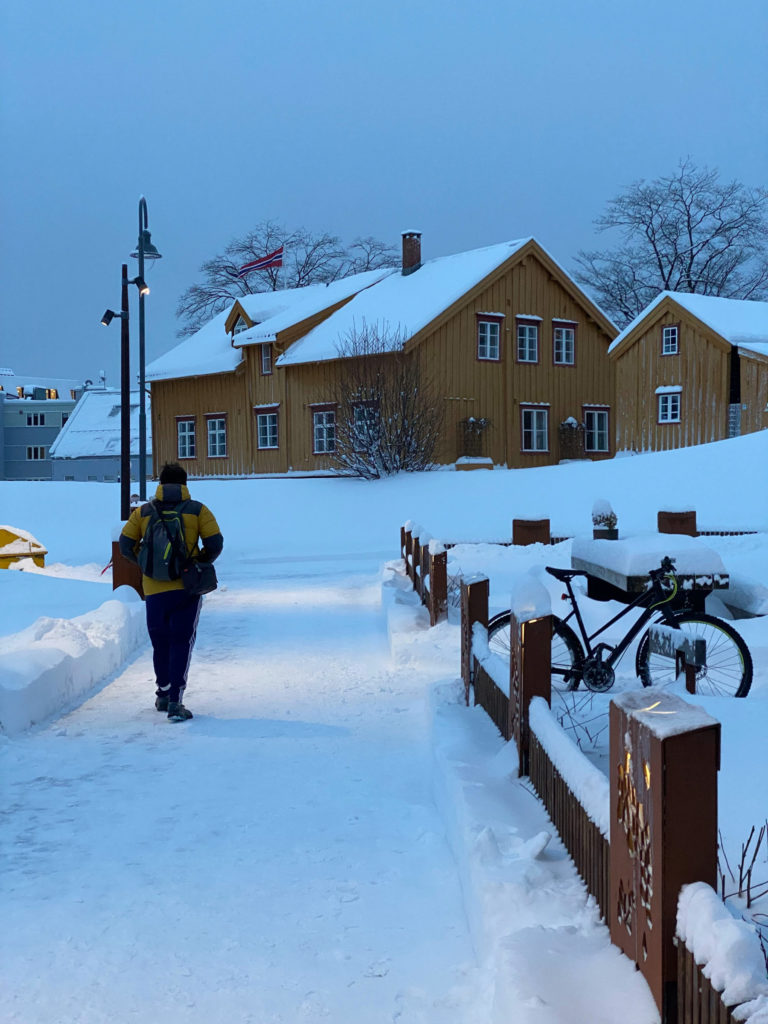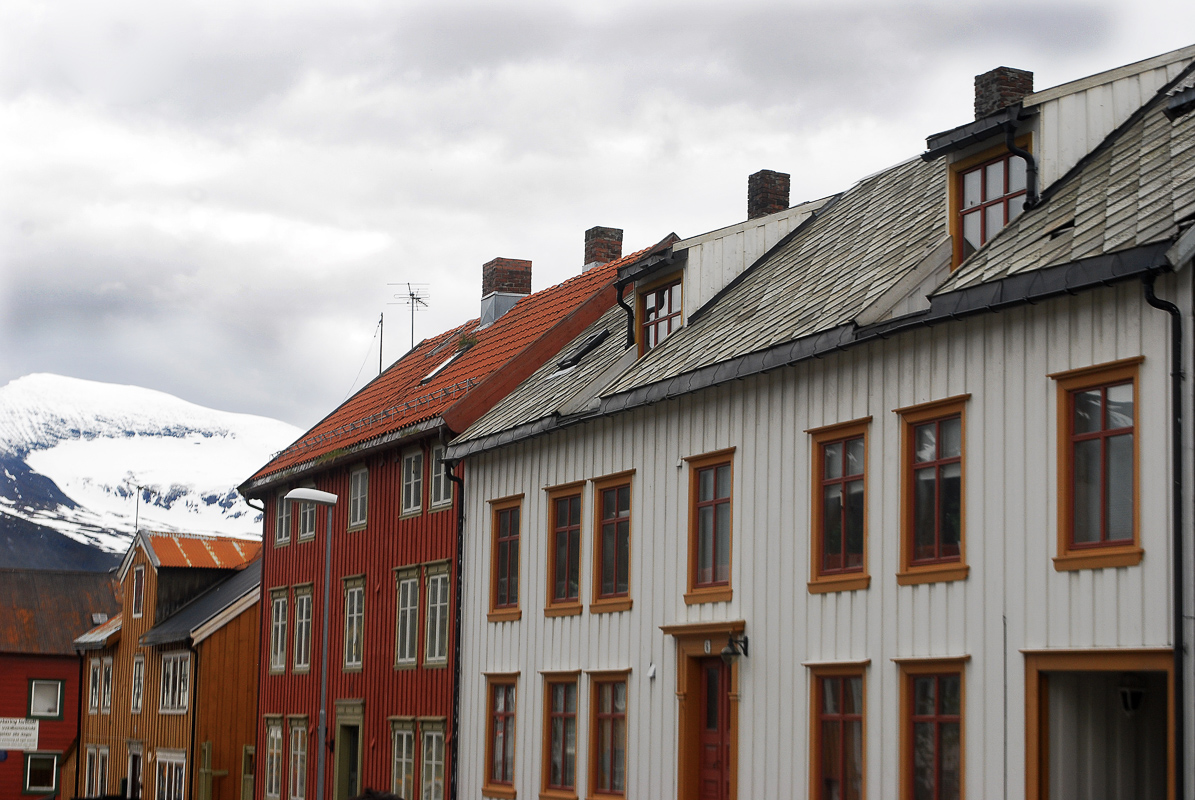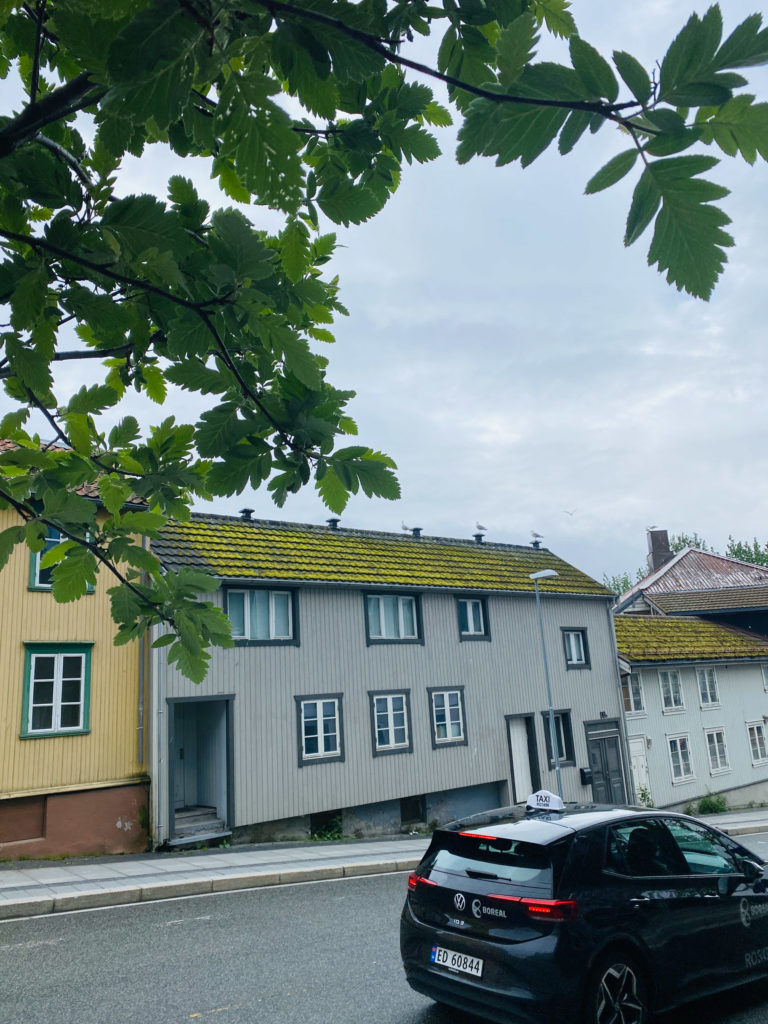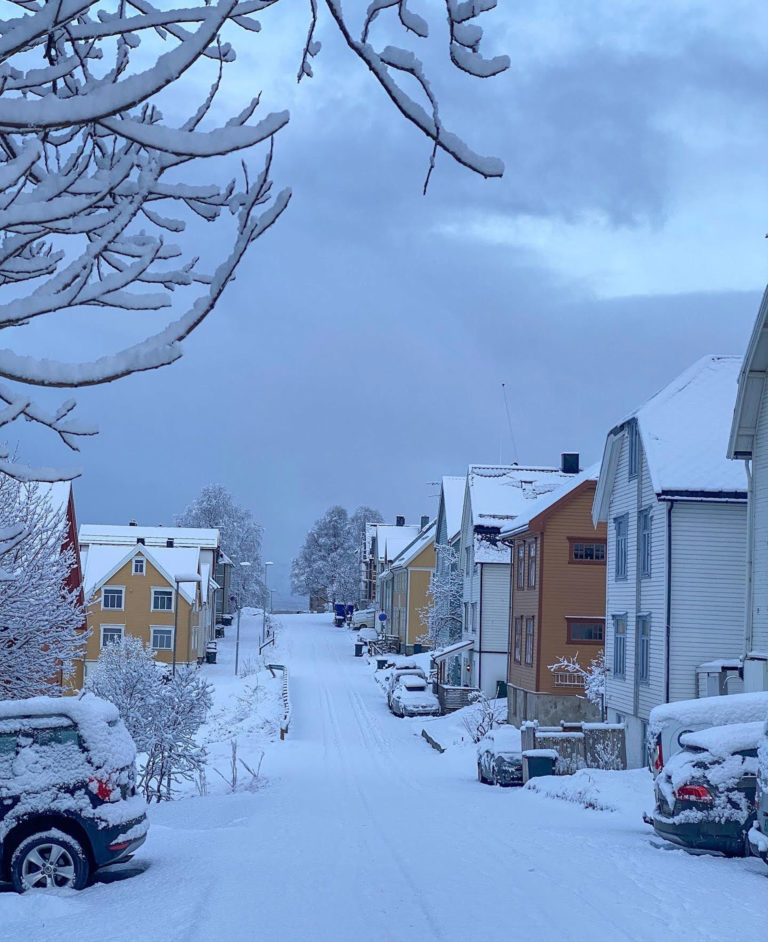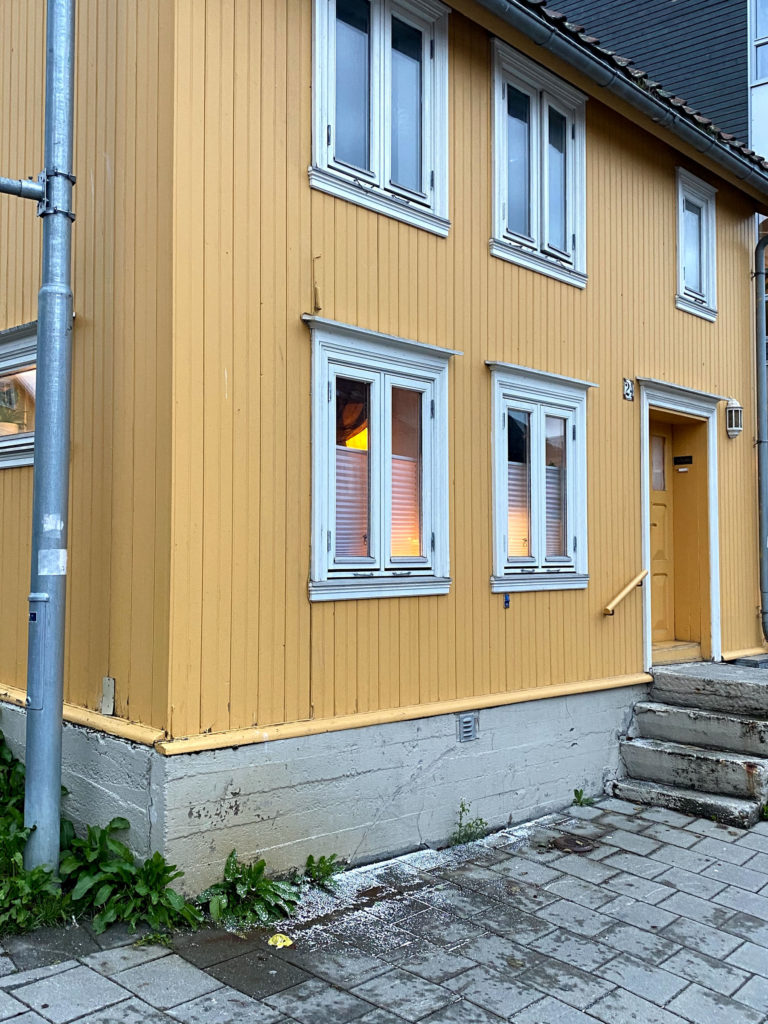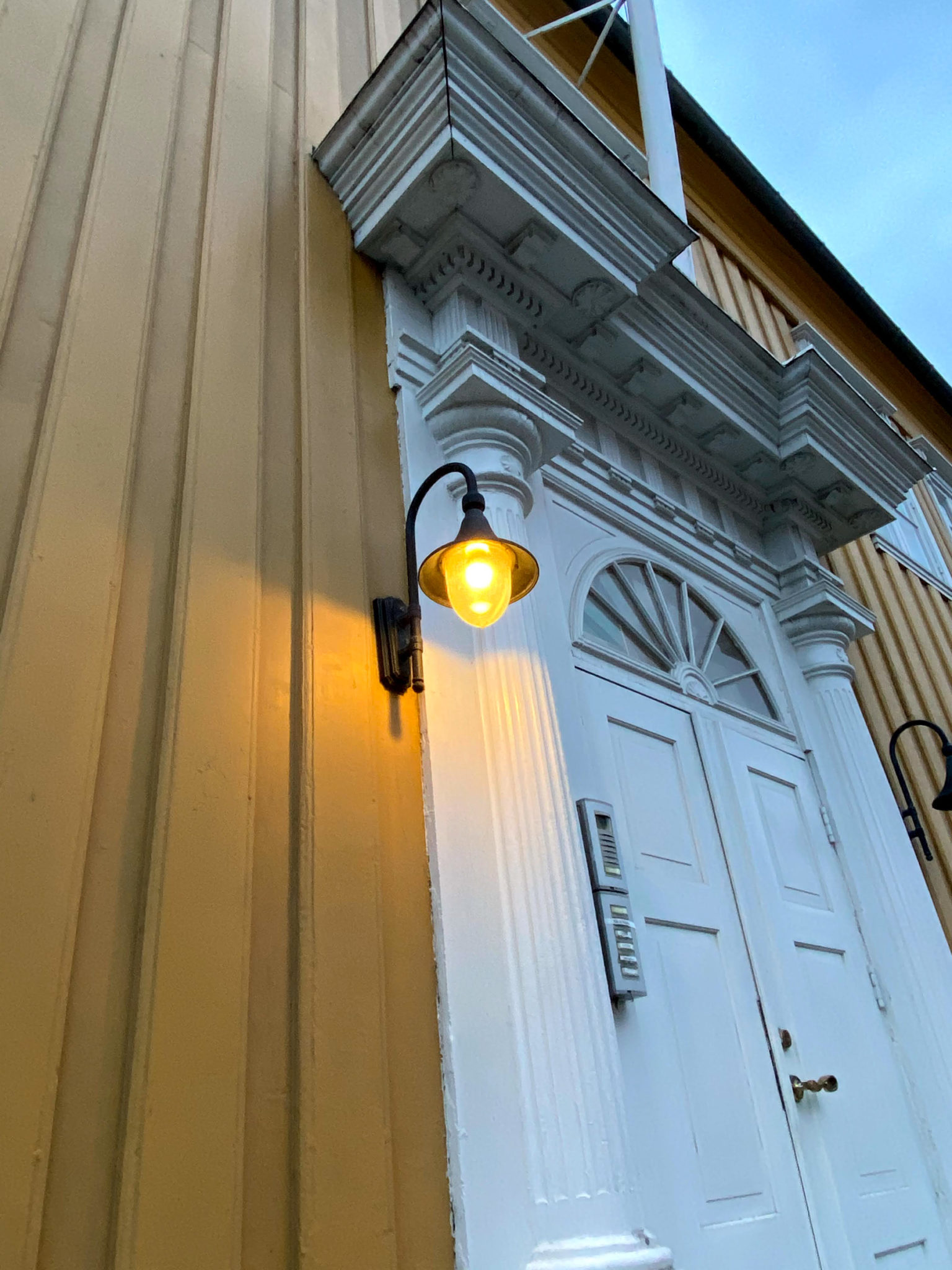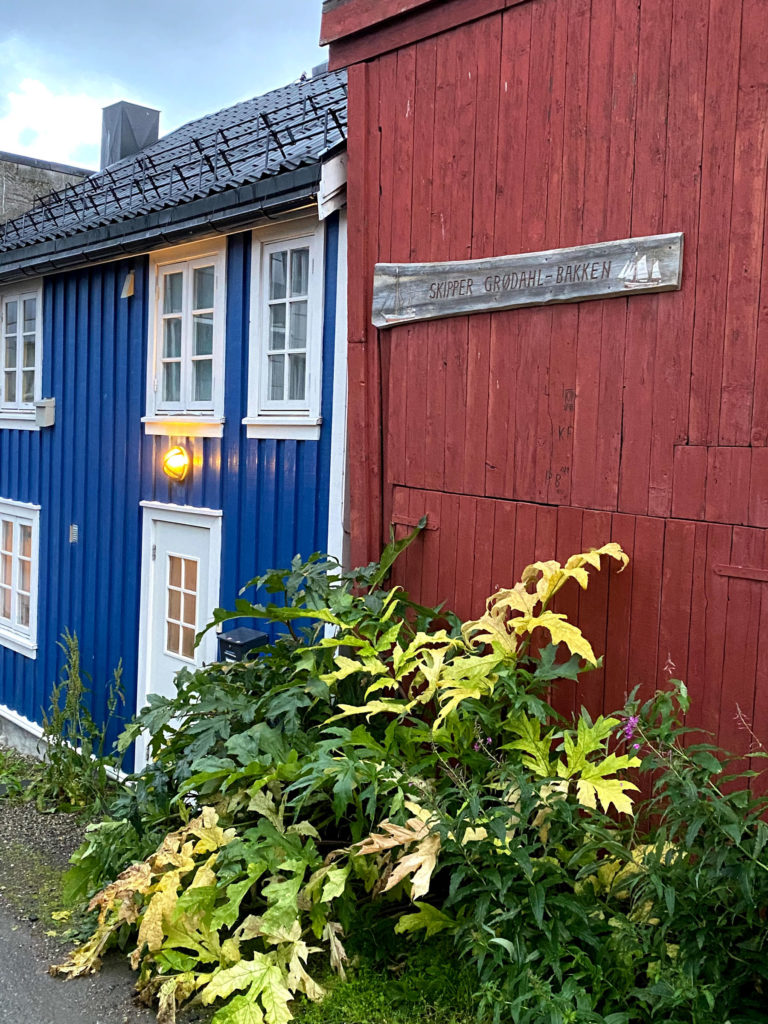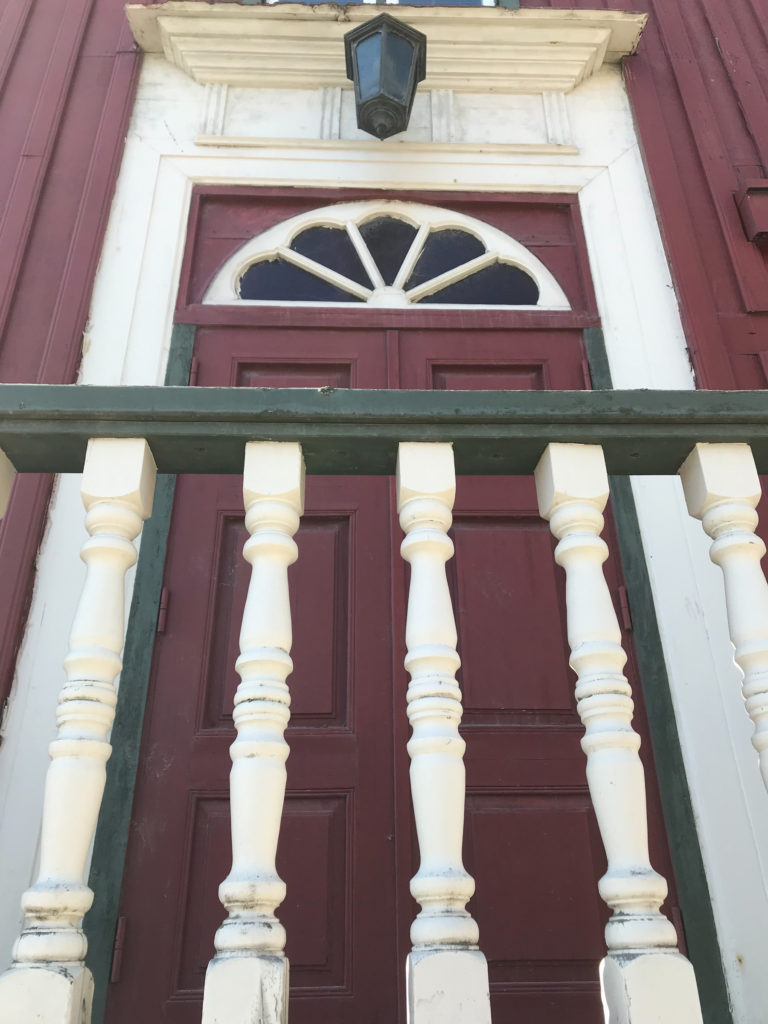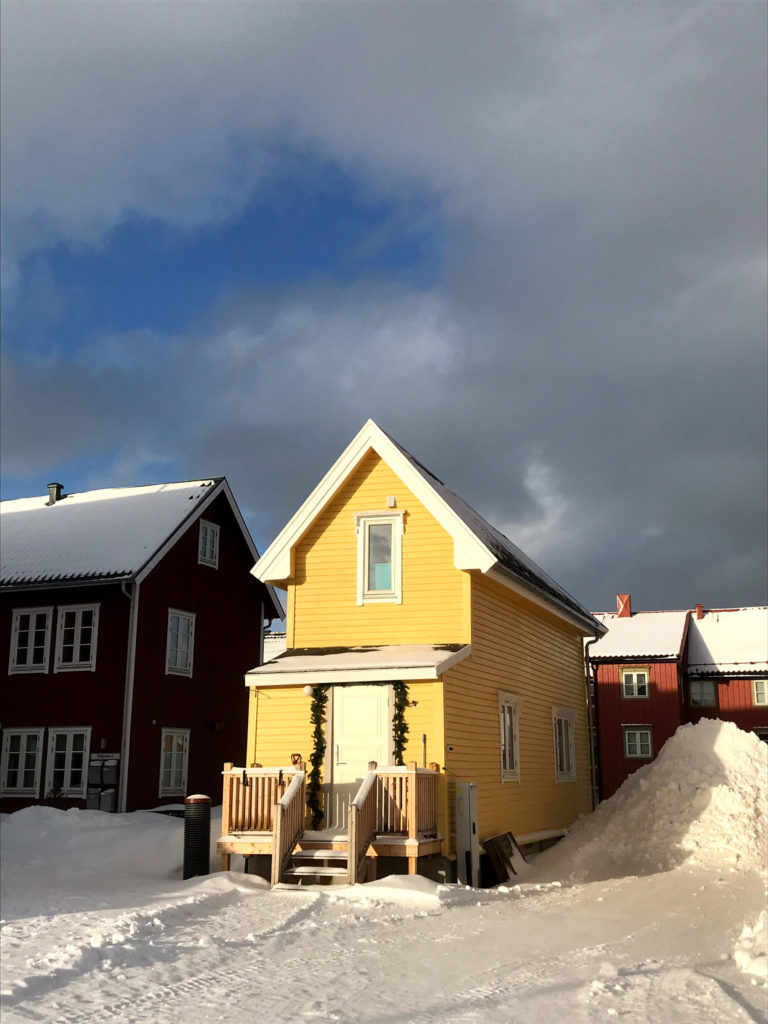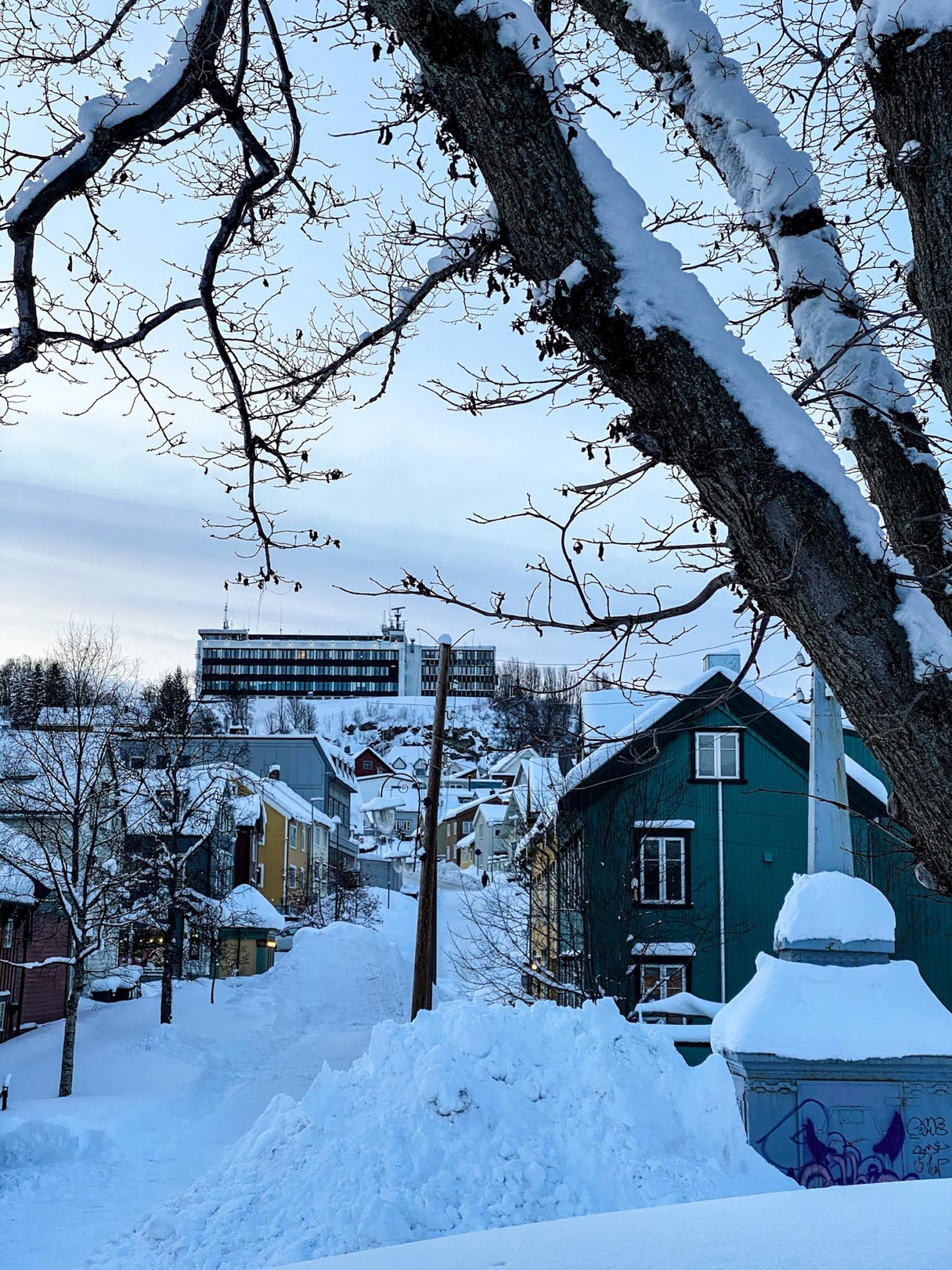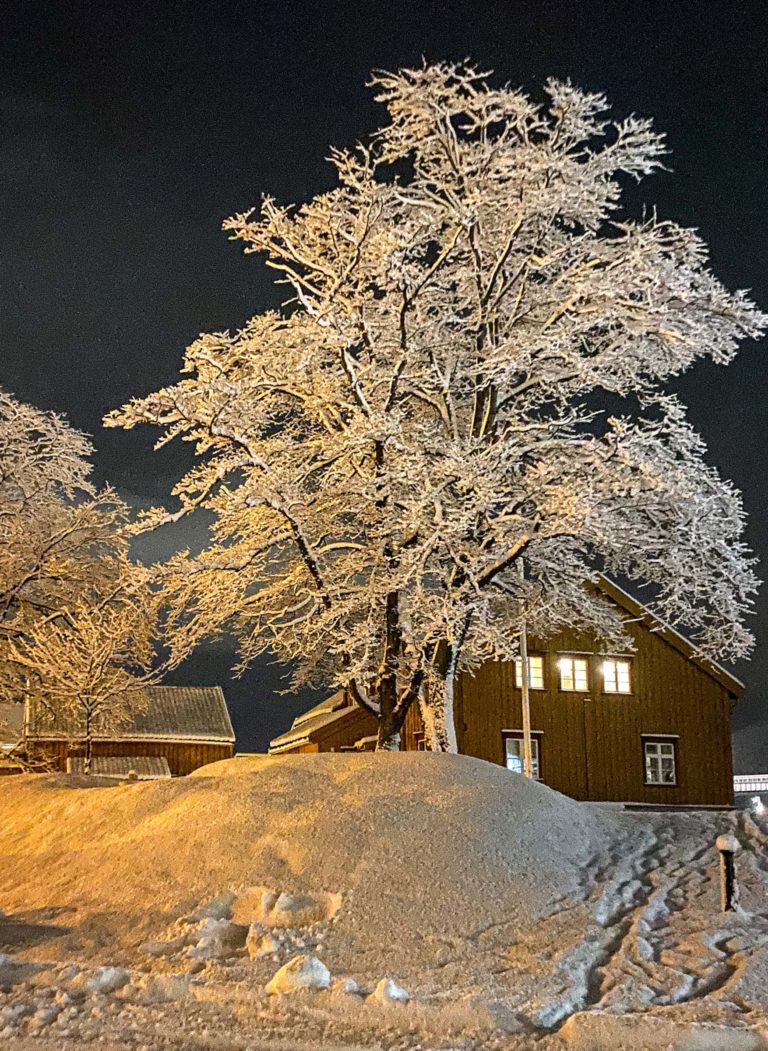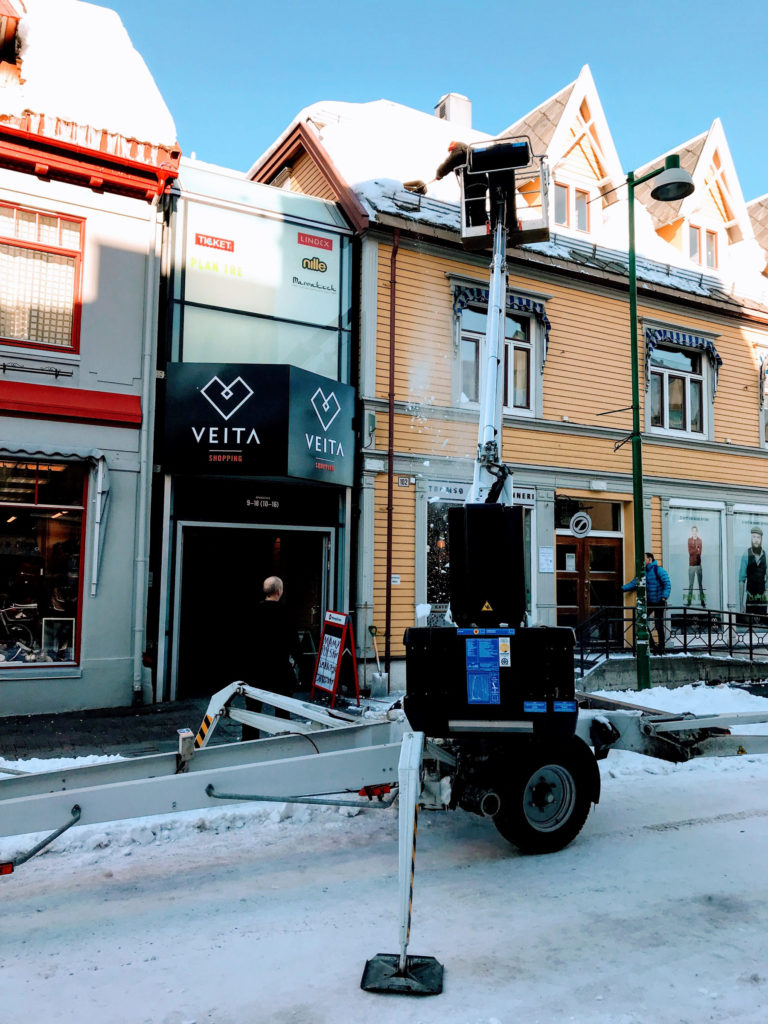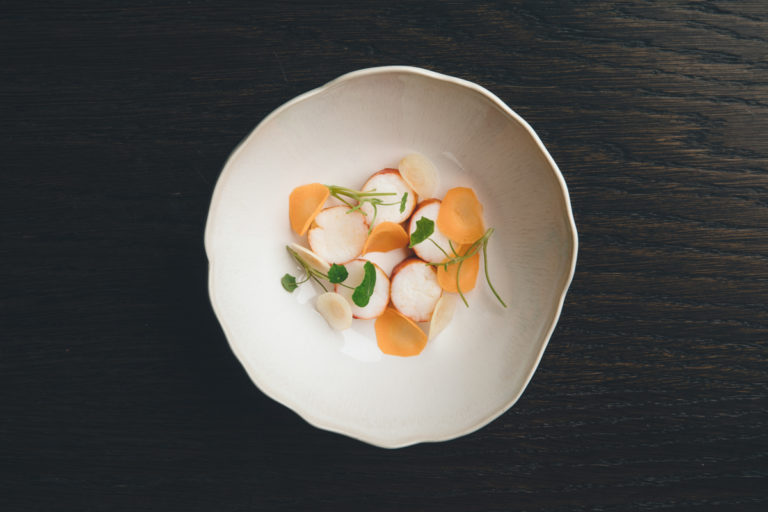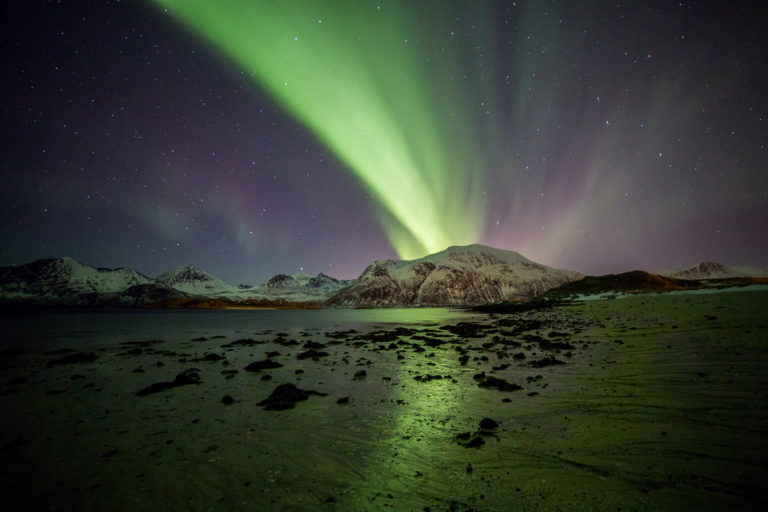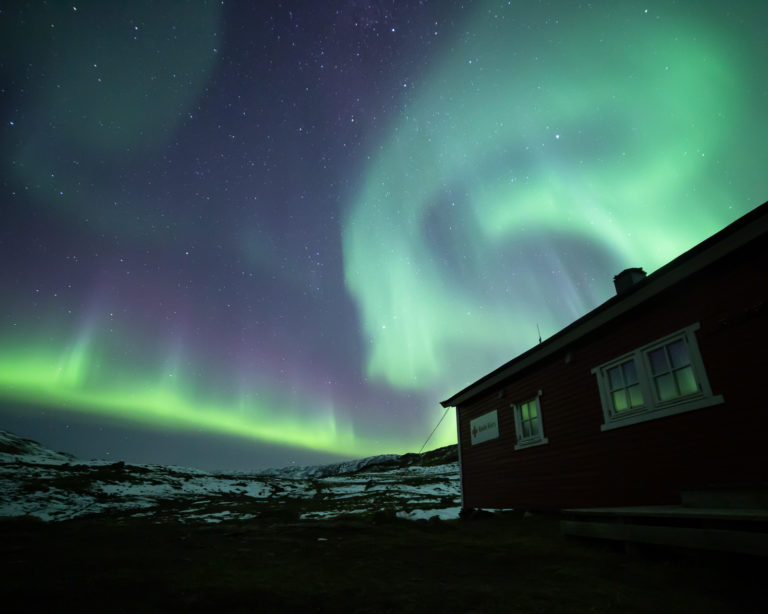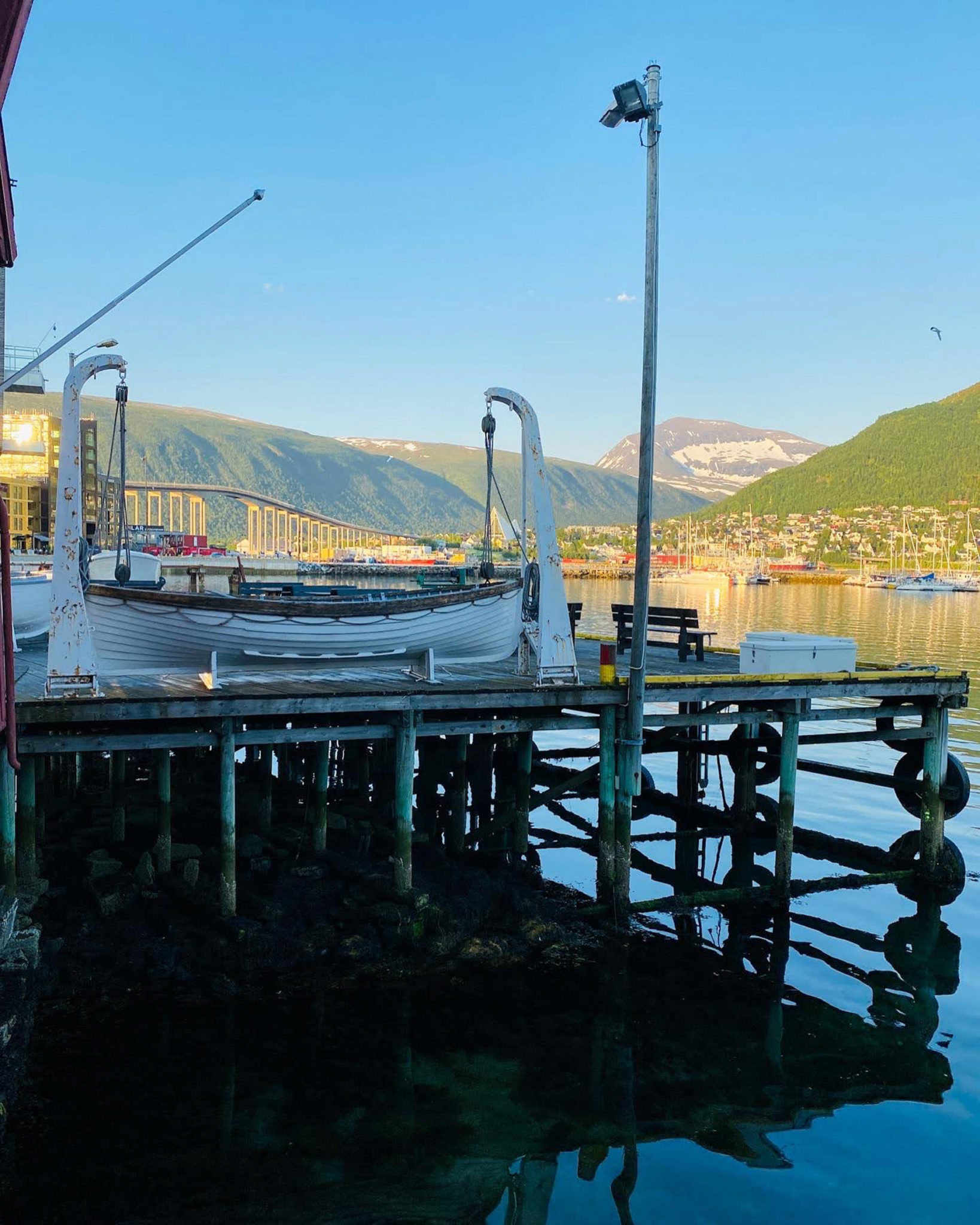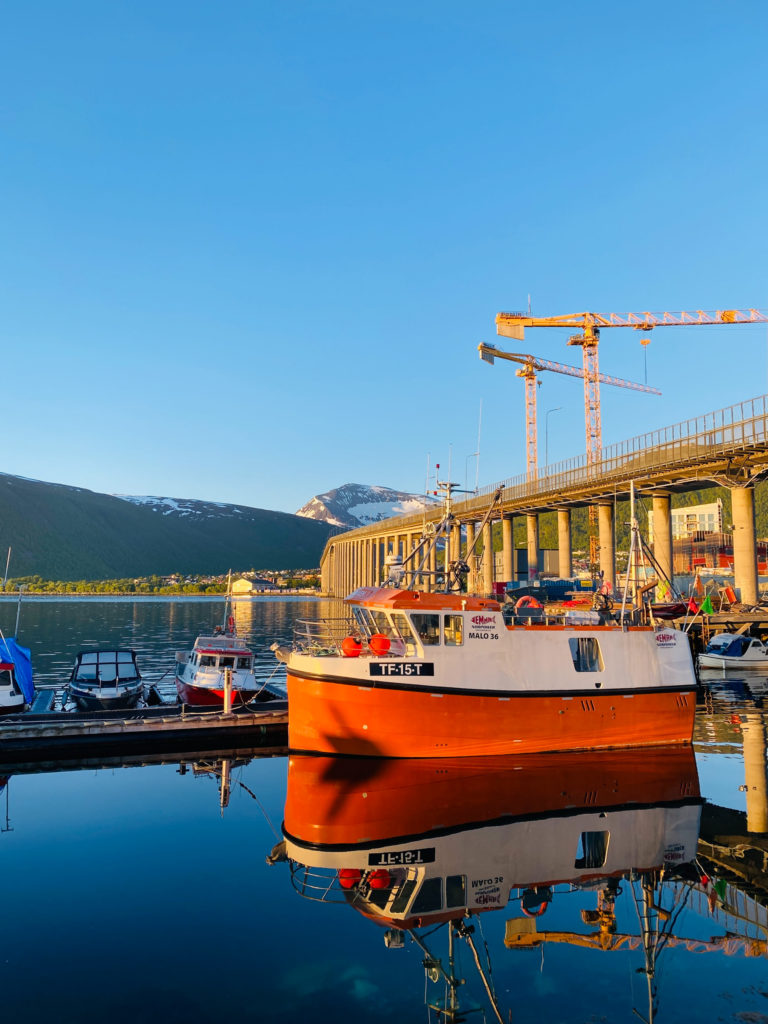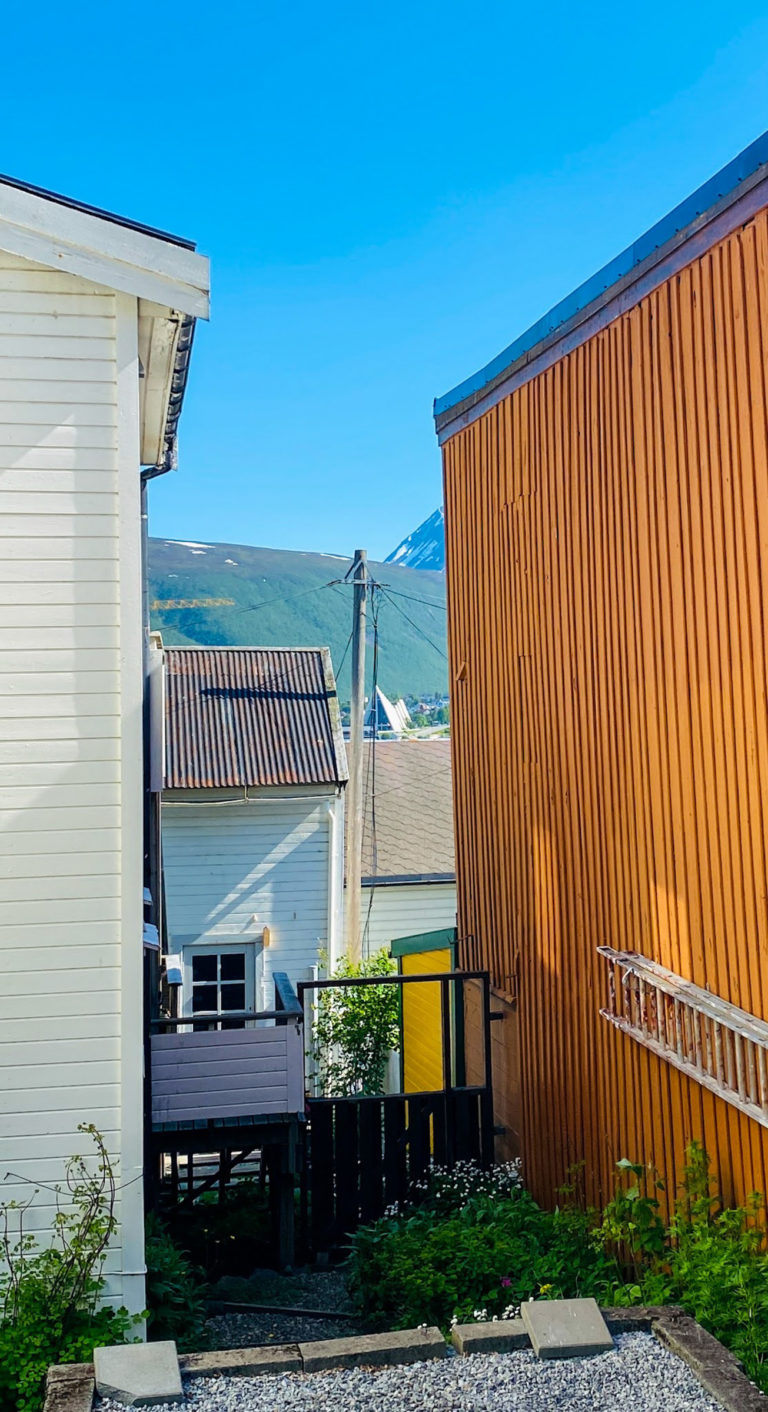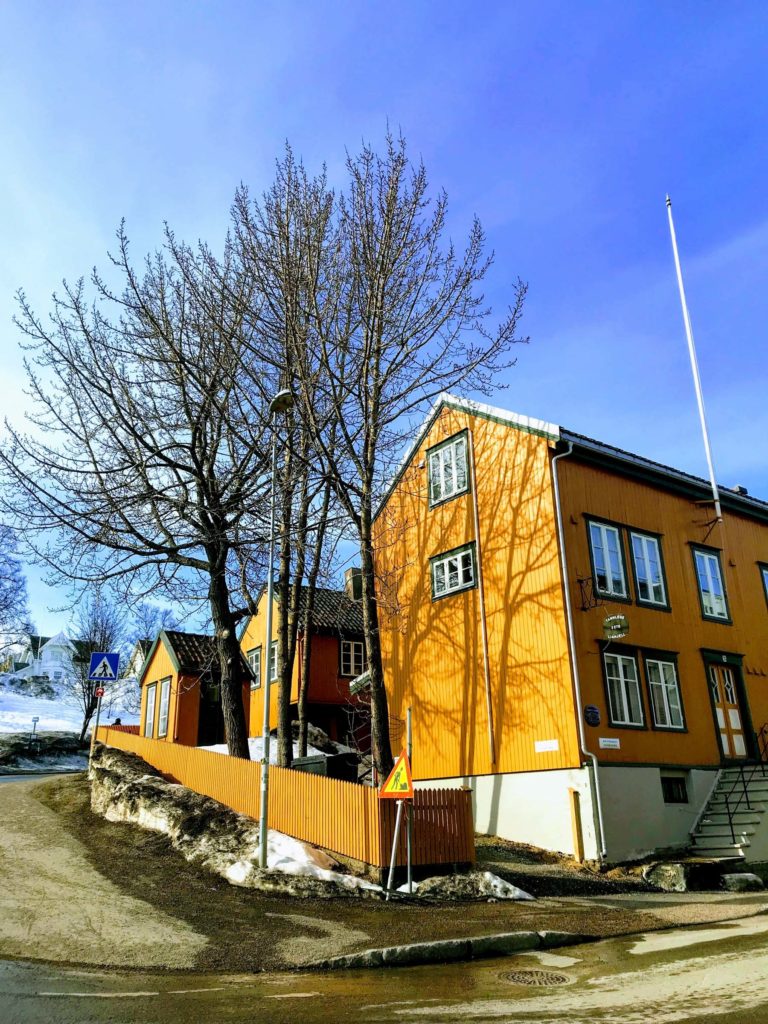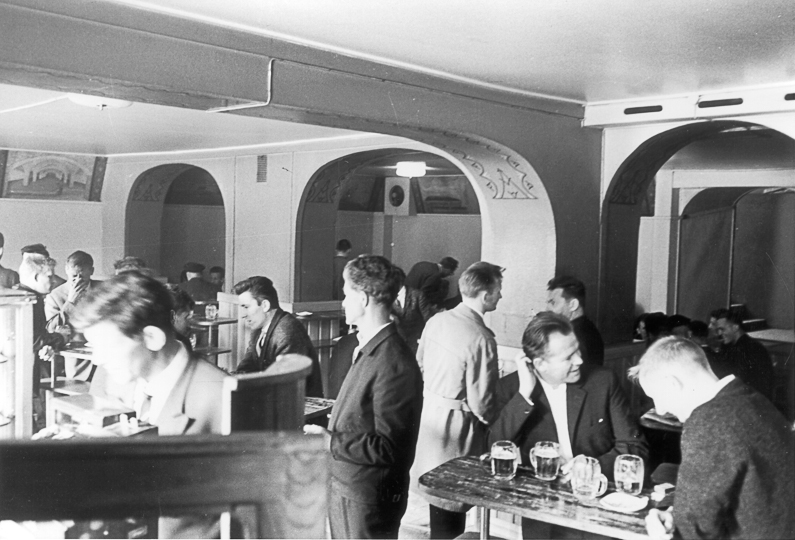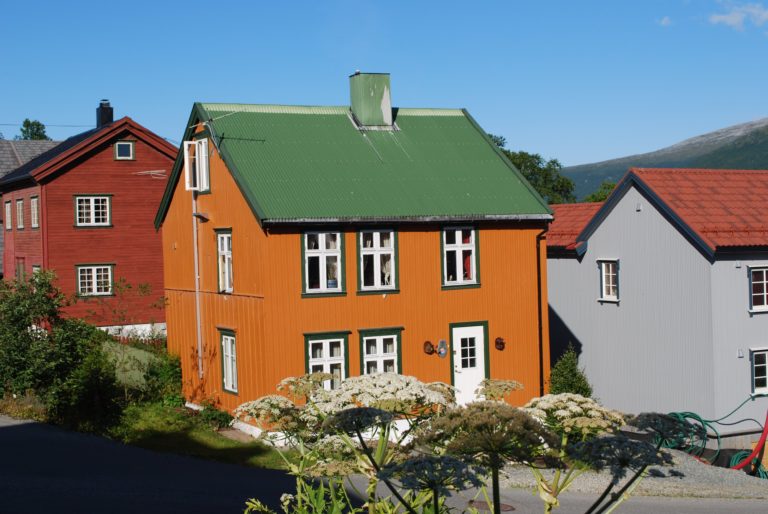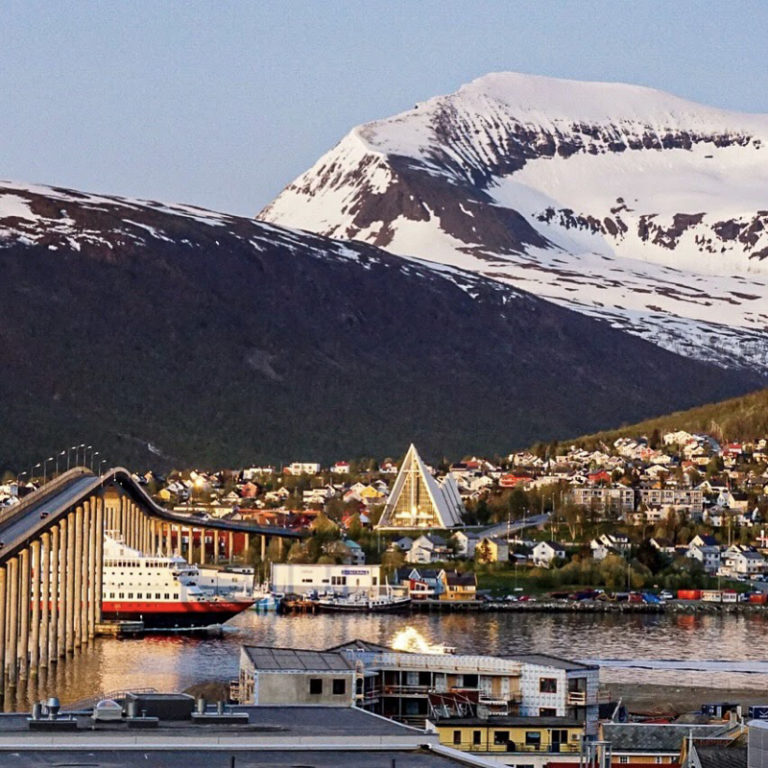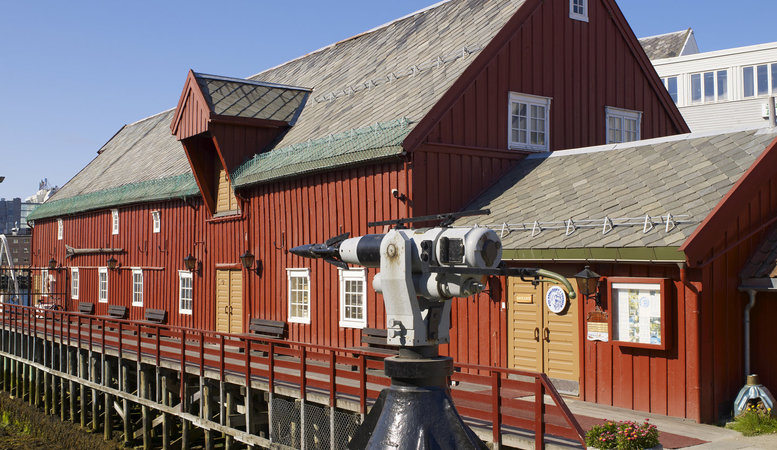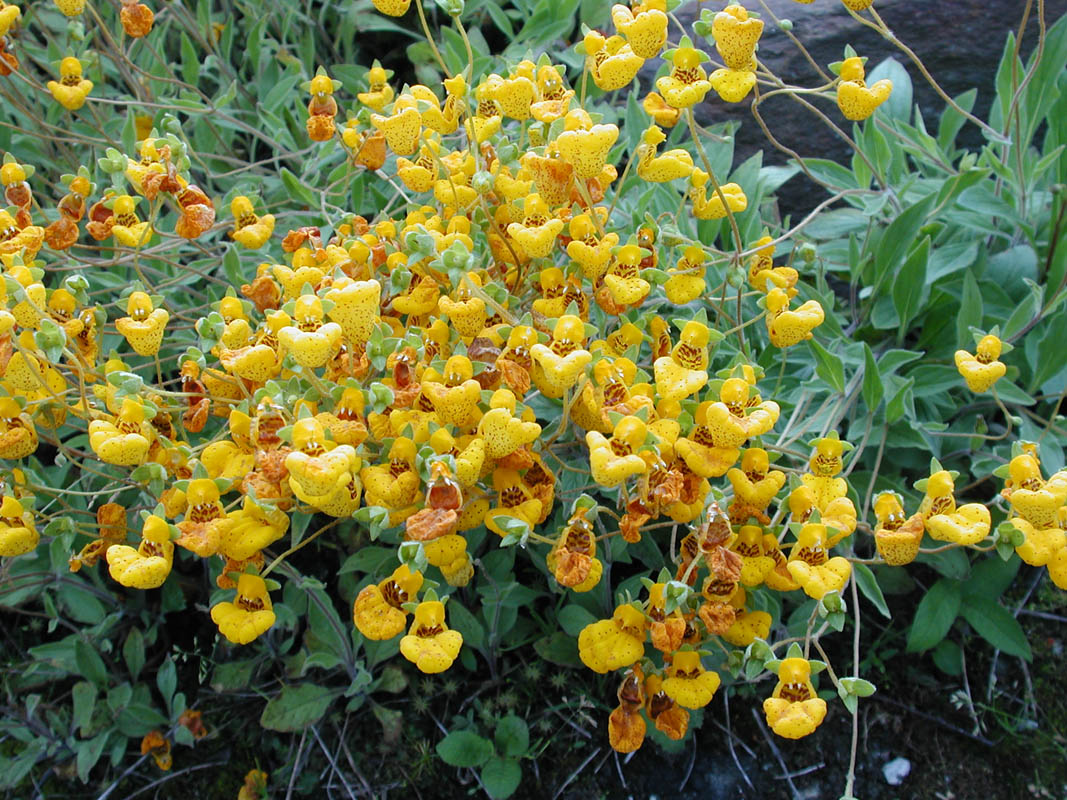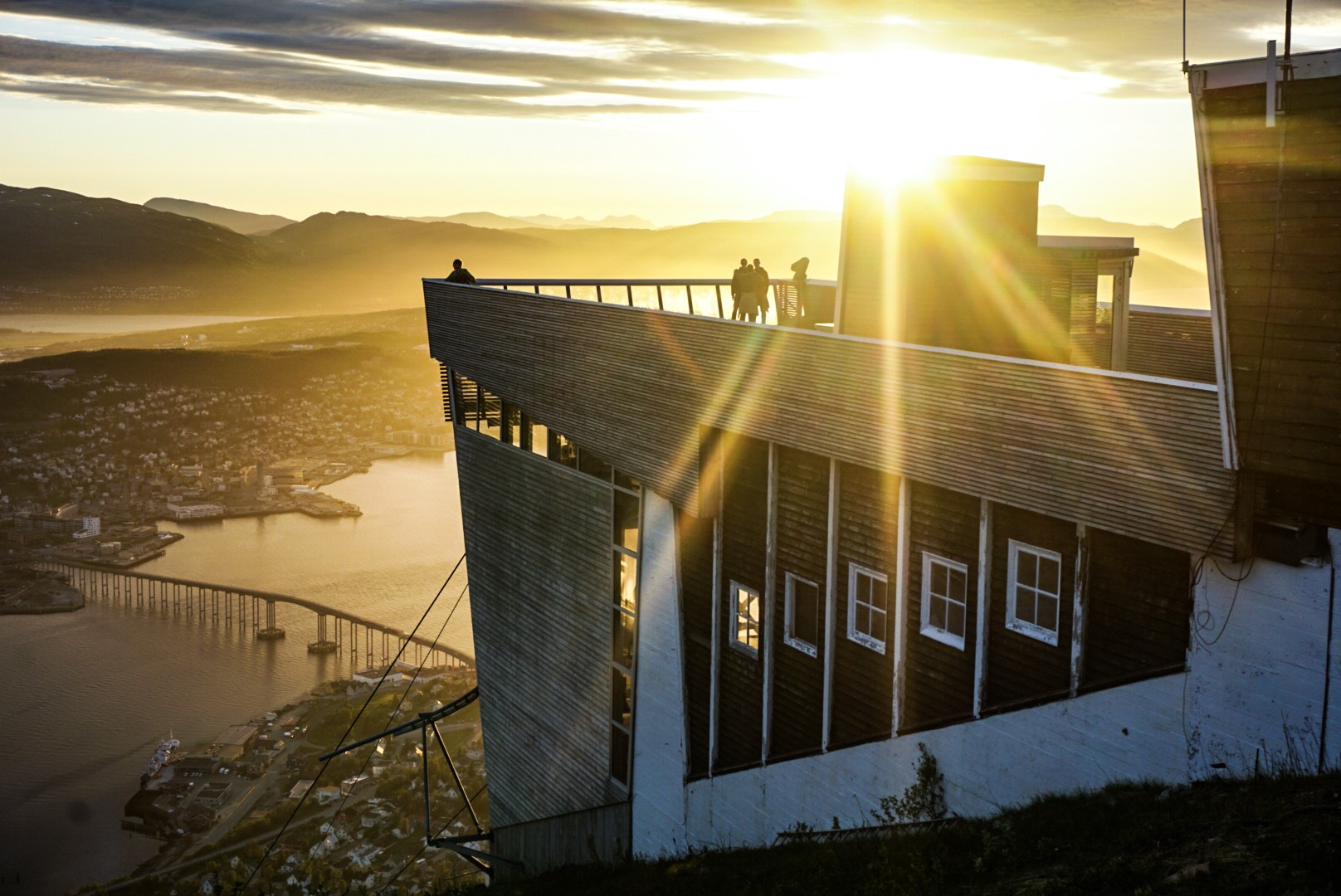There is hardly any order to Tromsø. Instead, the city centre is a mix of old and new, of architectural gems and hastily raised concrete, of dilapidation and wet paint. This is a suggestion for a city walk. Do it all in one go, interrupted by a beer, a coffee or a hot dog as suggested, or just take it in several turns. You can even read through it beforehand and look around on your way to restaurants, museums and attractions in town.
Walk the city of Tromsø
Roald Amundsen Square
The big explorer gazing out on the Tromsø Sound, surrounded by memorials reaching from utter tragedy to a bit of fun
Richard With Square
Memorial to the Hurtigruten, between a lovely empire style house and the Cathedral
Tromsø Railway Station
Tromsø Jernbanestasjon is 3,48 metres above sea level, but no train ever makes it here
Strandtorget Square
Old and new surround this lively square. Chances are you end up here at night.
Roald Amundsen House – Hard Rock Cafe
Roald Amundsen’s favourite place to stay in Tromsø, in a fine old house
Ølhallen – The Beer Hall
The oldest watering hole of town, from 1928. Ladies were accepted in 1970.
The Old Museum
The old city ends at this fine building, turned into a gallery of contemporary art
Prestenggata Street
Colourful, quaint street, mostly pedestrianised
Back in the Main Street
Walk the main street, like a true Tromsøite
The Cathedral Close
The 1861 cathedral, surrounded by modest and grandiose buildings
The Mack Quarter – Sweetheart
Turn into the old yard and cross into Sjøgata street through the passage amid old wooden walls
The Aunegården Bend
A section of well-preserved old houses from Tromsø’s first boom period in the early 19th c.
Looking up to the Library
The library has been declared the finest municipal library in the country
The Main Square – Stortorget
Big open square with lovely views, and a coffee opportunity in nice weather
Our Lady Church – Vår Frue Kirke
The world’s northernmost cathedral.
Perspektivet Museum and the Old Cinema
The northern end of the Main Street has a lovely little museum and the oldest cinema in Northern Europe
The Skansen compound
Tromsø’s oldest house, on top of a mediaeval mound
The Polar Museum
Tromsø’s history as a centre for Arctic hunting and exploration in an 1830 warehouse
Roald Amundsen turns his back to the city
A good place to start is at the Roald Amundsen statue. Roald Amundsen sailed as the first through the Northwest passage and was the first to reach the South Pole. His statue turns its back to Tromsø, instead he gazes out on the ship’s traffic in the Tromsø Sound. Raised in 1937, the statue dominates the triangular Roald Amundsen square. The French language memoral to his right, is in memory of the Latham expedition in 1928, when Roald Amundsen died in an attempt to rescue the survivors of the ill-fated Italia Airship expedition.
17 Tromsø Jews died in Holocaust
Infinitely much sadder is the memorial in the North-Eastern corner of the park. It is in memory of 17 Jewish tromsøites who were arrested by the Nazi authorities in 1942. All of them are men, as the women had escaped to neutral Sweden. The men stayed beind to look after their businesses. They were sent to Oslo, and from there with the prison ship “Donau” to Szczecin (formerly Stettin) and finally by cattle train to Auschwitz. Some of them were killed the first day in the gas chambers, others were worked to death over the next months. One young man lived to come back to Norway but died soon after. On the walk, look out for the” Stolpersteine” – stumbeling stones – little brass plaques in memory of each single Jewish person that died.
The Eidis Hansa Stone is an old pub brawl
A red, big stone adorns the upper end of the triangular park. This is the 371 kg heavy Eidis Hanssen stone (Eidis Hansa in local dialect), placed on the site of an old tavern. When the good Eidis Hansa was refused entry here, he carried (rolled?) the rock from the beach (the lower end of the park) and dropped it on the doorstep. The tavern is long gone, but the rock is still here. Exactly when this happened is poorly documentet, but the story has been told a good 200 years in Tromsø. Before leaving the triangular square, have a look at Northern Norway’s Art Museum. This previous post-office has free entrance and a collection of Northern Norwegian art, as well as interesting temporary exhibits.
Strandgata street starts with a lovely, yellow house
Ignore the cathedral on your right and turn left into the Strandgata street. There you pass the memorial to the founder of the Hurtigruten, Richard With. Although his genious shipping idea was conceived in the Vesterålen Island, he was born and bred in Tromsø. The lovely, yellow corner house dates from around 1820. Its style is the Neo-classical style with a lovely door facing Strandgata. Peep into the backyard and see the dilapidated charm of old houses and Tromsø palms. Also peep in between Kaplan and Risø Coffee shop for a backyard so far ignored by developers.
No train ever comes to the Railway Station
On the left, lower, side is the railway-themed bar Tromsø Jernbanestasjon. Tromsø is well north of Norway’s rail network, but the bar sports railway seats and uniformed staff. The announcements are along the lines of “Railway is late due to reindeer on the track” and the like. This may be a little early for a break from the sightseeing walk. Or maybe not.
Strandtorget is a lively little square
The little square Strandtorget can be quite lively both summer and winter. The dock in the middle is where the ferry left for the mainland before the building of the Tromsø bridge in 1960. The yellow building on the northern, left side of the square dates from 1820, and is one of the oldest wharf houses in Tromsø. Skarven, the next-door bar, is an old fish factory turned into a popular café. If you come in the evening, you will find plenty of welcoming bars around the square.
Turn into the main street south
Storgata is Tromsø’s main street and heart. The red building, now housing Hard Rock Café, on the right, upper side is where Roald Amundsen used to stay when he was in Tromsø. He was always taken in by the chemist Fritz Zapffe. Zapffe’s son, Peter Wessel Zapffe, was a celebrated mountaineer and writer. Continue south some three blocks to the brewery compound. On the left, lower side, there is Blåst. This is a small glass factory where you can even try to blow glass yourself.
Ølhallen is Tromsø’s oldest watering hole
This is Tromsø’s oldest watering hole, dating from 1928, housed in the basement of Mack’s Brewery. Seal and polar bear hunters told stories from their exploits in here, stories growing more and more fantastic with time. Women were unwanted until 1970, when after some pressure (ehem) the brewery installed a new lavatory for the boys. Then the girls got the old one. If you have promised yourself to live a healthier life, the historic background of this pub is a wonderful excuse to make an exception to the rule. Ladies should of course have a beer just to set an example.
You can stop at the old museum for some contemporary art
You can also go on guided tours in the brewery itself, next door to the Ølhallen. To carry on, go uphill into Muségata, where you can stop at the Tromsø Kunstforening (Tromsø Gallery of Contemporary Art). The building dates from 1894, and used to house the Tromsø Museum, today The Arctic University Museum of Norway. Now, it works as one of Norway’s leading art galleries. Of course, the Polaria Experience Centre is down at the waterside. But that’s a different story.
Prestenggata is a colourful street
Prestenggata street is an old residential street, where working class people used to live. Today, it is pedestrianised and fun to walk in, and the residents tend to be young and urban. Turn right and go down Strandskillet (“skillet” means “divide”), Tromsø’s first city border from 1794 and into Storgata, the main street, at the Scandic Grand. The modern building is a successor of the Hôtel du Nord from 1839 – the first proper hotel in town.
Walk the main street to the church park
Walking the Storgata a few metres towards the north, you come to “the church park “ (Kirkeparken) with the Tromsø Cathedral in the centre. The upper end of the park is a colourful row of low, wooden houses. The first church in Tromsø was, according to the saga, built in 1252. We don’t know what this church looked like, but it’s very likely it was built at around the same spot as today’s cathedral. Drawings of a church from the early 18th century are preserved, and the church of Elverhøy in the residential areas outside town is a predecessor moved out of town to give way to the present structure.
The church is Norway’s only wooden cathedral
The present cathedral dates from 1861 and is the only cathedral in the national Church of Norway built in wood. With 800 seats, it’s also one of Norway’s larger wooden churches. The style is neo-gothic. The church is often open, and sometimes there are tourist concerts. Inside, you note the richly ornamented interior, and with some luck you get to hear the organ, built by the master organ builder Claus Jensen in 1863. It has now been fully restored.
The church park is flowering from early to late
The church park has been lovingly restored in 2018. From March-April until October, there are flowers blossoming here, from snowdrops to gentians. In July, the roses on the southern side are a nice surprise. In the north-western corner, there is a memorial to the victims of the second world war. The bust on the northern side is in honour of composer of the tune to Northern Norway’s national anthem, Adolph Thomsen, an organist in the cathedral. Make sure to walk all around the cathedral to see it from all angles. The “church canal” on the back is a photographer’s delight, because the cathedral mirrors in it.
Stone buildings form the northern end of the church park
The middle, cream house north of the cathedral is called “the stone house” (Stengården), and was the first attempt of building in brick and mortar in town, dating from 1880. During the Nazi occupation, it was the headquarter of the Gestapo, and members of the resistance were tortured in the basement. The grand, vividly orange building is the Tromsø Savings Bank, dating from 1913. This is a rather stately Art Nouveau building, with rounded corners and organic shapes. In stark contrast on the other side is the Bank of Norway building from 1972.
You have reached the epicentre of Tromsø
The bustling crossing of Storgata and the street Fredrik Langes gate must be characterised as the absolute centre of Tromsø. Do notice that the street is slightly wider for a bit here. In the post war years, one planned to widen the main street by demolishing all the old houses on the upper side. This was fortunately not carried out.
Old of a sudden, it’s old again
The mid-section of the Main Street is a hotchpotch of old and new. Stop at “Sweetheart”, a modest, red shack-like house. This used to be an outhouse for an old merchant. Walk into the yard on the lower, left side, and take the tunnel-like passage into the next street, Sjøgata. Then you see that the old house, the yard and the front building is part of the same complex. Once, all houses in Tromsø had a complete backyard with outhouses, stables for horses and even cows and sheep. Now, most outhouses and stables are gone, since their functions have disappeared.
The curve of Sjøgata is part of the first city
Most of the city centre of Tromsø follows a grid pattern. However, the Sjøgata street has a strange curve in the middle. This is because it follows the shoreline from 1794, the founding year of Tromsø. The houses on the lower side are wharf houses, originally built on stilts into the Tromsø Sound. On the upper side, there is a row of merchants’ houses with stately doors. 200 year ago, this was the place to see and be seen in Tromsø. Since then, the hustle and bustle has moved one street up.
In the city fire of 1969, 29 houses burned
Moving north along the Sjøgata, you suddenly see concrete taking over. In 1969, a giant fire ruined a compact area of wooden houses, and 29 of them burned. The reconstruction was lengthy and badly planned, so this area is nowhere to linger. Instead move back into the Main Street and take a step to the left (south) and look up the street Cora Sandels gate (next to Burger King) to Tromsø’s award-winning library. This is a conversion of a the Fokus Cinema from 1970, turning massive concrete into light-weight transparency. Then turn and move north.
The main square is a fire block
Suddenly, it all opens. You can see down the main square, Stortorget, to the Fishery and Hunting memorial, and across the sound to the Arctic Cathedral. On your left, the merry jazz tunes from the minuscule kiosk Raketten (“The rocket”) invites to a hot dog or an al fresco beverage. The Catholic bishop’s residence behind is a lovely neo-classical house from 1830. Move up the square to the little church, the Pro-Cathedral of Our Lady, the world’s northernmost cathedral. The Catholic community dates back to 1860, and the church was opened in 1861. The church is often open. From here, you can see the space up and down, constituting a fire block. In 1969, this worked, as the houses on the northern side were spared from the devastating city fire.
The upper end is Tromsø’s civic centre
When looking around from the Catholic church, you see the Culture House (Kulturhuset) straight across, the new and modern city hall up to the left and the old city hall right in front. This 1864 building is now a stage for alternative music and theatre. Before this, in 1843, the world’s first cross country ski competition took place here. The information on this event is scarce, but it seems to have ended in drama: A Finn won because he used two sticks, the other competitors had the traditional single stick.
The Salvation Army is in Hell’s Lane
Walk a few metres past the Catholic church, and head down the little lane officially named Schanckesmuget (Schanche’s lane). It’s popular name, though, is Helvetesveita (Hell’s Lane). In Norwegian “helvete” (hell) is a favourite swearword. The lane used to be known for alcohol-induced trouble around a tavern. As one says in Tromsø; “there was a lot of hell there”. However, the tavern was later replaced by the Salvation Army!
The old cinema is next to the small local museum
Rather well preserved with a colourful row of houses, the northern end of the Main Street looks welcoming. The cinema Verdensteatret is among the oldest cinemas in Europe in continuous use. Cineastes should look out for their programme; others could have a coffee in the cosy foyer. Next door, the little town museum Perspektivet is housed in what is maybe Tromsø’s most magnificent merchant’s residence from 1838. Enter for a small, free of charge exhibit on Tromsø’s history as well as a fun photo exhibit in their downstairs café.
Bergen and Trondheim styles face each other in the northern end
The Perspektivet Museum faces another lovely house from about the same period. Both are built of wood in the neoclassical style fashionable in the first half of the 19th century. However, the Perspektivet Museum is built in the Bergen variety, as the merchant came from that city. It has one magnificent doorway in each end of the façade, a dominant curved roof and horizonal panelling. All this is typical for the city of Bergen. The house opposite used to have central doorway, its façade being slightly modified, its roof is straight and more modest and the panelling in vertical. This is typical for cities like Trondheim and Kristiansund in Central Norway. Both styles are represented around town, but here you see them facing each other.
Head down to more old houses
Another attractive row of houses is found along the square Ingvald Jaklins plass. Follow it down to the street Skippergata. Number 11 is a well-preserved grey neoclassical house, where the whole compound is preserved. The oldest garden in Tromsø is found on its southern side, and this being an outdoor café, you can enter and have a look at the perennials typically grown in 19th c. gardens. Have a look inside the backyard with red-painted before continuing north and right into the street Nordre Toldbugate. Everywhere you are surrounded by old houses in different colours.
Skansen is Tromsø’s oldest house
Perched atop a little mound, you find the yellow house called Tollbua (“The Tarif House”). This oldest house in Tromsø was built around 1790 to administer the taxation of trade. In 1788 the city of Bergen lost its trade monopoly on Northern Norway, and the northerners were granted free trade. There were, however, still tariffs and taxes to be paid, so this house was built to tax all the new trade.
The mound is the oldest construction in Tromsø
The mound, on which the house is built, is much older. It is usually dated to the 13th century, although it is not mentioned in any written records. A circular earthwork, it was at the time surrounded by the sea, with only a little moat on the western side. Although the records are lacking, one often sees the little fortress at a part of the conflict between the Kingdom of Norway and the Republic of Novgorod in the late Middle Ages. The cannons were placed there during the Napoleonic wars. The big elm trees are surprising in this sub-arctic climate.
The Polar Museum is a well-preserved warehouse
Dating from the 1830ies, the Polar Museum was the warehouse for the “Tarif House”. The machinery to haul up goods is preserved and inside, the doorways are small and low. The museum is a key to understanding the history of Tromsø and should not be missed. There are a few metres of original beach under and beside the Polar Museum. Elsewhere in town, the original beach has fallen victim to development, so these few metres are the last in the inner city.
Walk back past the colourful wharf houses
To return to the inner core of the city, walk along the warehouses along the port. They were built in 1903, after a fire in the area. Since wooden houses were banned in cities in 1904, these are among the latest wooden houses in town.
Wander around the Northern End
Avid street walkers can decide to make a few detours out of the compact old city. All are easy to do, although they can be slippery in winter.
- Tromsø’s new development is found just behind Skansen, where the old shipyard has been converted into posh appartments, complete with bars and restaurants. Go here for the view!
- Verftsgata is a little street with old houses immediately north of Skansen
- A few old houses are also found just north of the bridge, including some nice doorways
- The area around the top of Nordre Tollbugate street affords a great view of the city. This used to be a working-class part of town, and the houses vary from cute through dilapidated to replaced by new and modern.
- The Kirkegårdsveien street has a lot of nice villas from around 1900, built in the Swiss Chalet Style, with a few stone houses built in an English cottage style.
Many styles are present in the inner city
Tromsø is a hotch-potch of styles. Here are some of the colours you can look for.
- Traditional Northern architecture: In parts of town, notably the northern end, there are numerous houses built like farmhouses on the country. They are small and modest, and often they have odd shapes because of extensions having been added.
- Neoclassical or classical style was in vogue in Tromsø in the early 19th c. It is characterised by wooden architecture imitating the dominating architecture of Europe at the time. Look for column imitations around the doors, window frames with tooth pattern and other classical detail.
- Gothic revival and Swiss chalet: Historicism, being inspired by the past, dominated Western architecture in the latter half of the 19th c. In Tromsø, there are neo-gothic churches, “translated” into wood, as well as houses in the “Swiss chalet style” with their rich ornamentation, first and foremost a few streets away from the main street
- Art nouveau: In 1904, the city of Ålesund was devasted by a giant fire. This caused the government to ban wooden houses in towns and cities throughout Norway. New houses in Tromsø were thus built of stone or brick, and preferably in the Art Nouveau style in vogue at the time. This was followed by Art Déco in the 1920ies and functionalism in the 1930ies and 40ies.
- Reconstruction era: Tromsø was spared any war destruction. However, the buildings from the 1950ies and 60ies were built in a very simple, or even frugal style, mostly on a low budget. Or maybe we haven’t learned to appreciate them yet? They are often revamped with more up to date facades and bigger windows. However, there are a few pearls of modernist architecture among them.
- Oil age architecture: Norway’s wealth during the 1995 to present oil boom is visible in both civic architecture and the development of apartment buildings. From vantage points, one sees how voluminous they are, dwarfing the traditional architecture.
Can this walk be done in winter?
Tromsø is walkable all year, although streets can be slippery, and you’ll have to jump over snow heaps left behind by the snow plough. If you have bad shoes and insufficient clothing, this can be a threat to your health and wrists. However, with spikes on your shoes and proper winter clothing, the obstacles are but entertaining. Camera in hand, you’ll get lots of great shots.
Good to know about Tromsø
Even the most patriotic Tromsøite is aware of the huge difference in size, history and socio-economic importance between Tromsø and Paris. However, the German traveller G. Hartung was very impressed with the language skills, the level of education and the orientation of the rest of the world within Tromsø’s gentry. The ladies were also dressed in the (second) latest fashion. He thus wrote “If the far north should also have its Paris, it should be Tromsø”. In short…Tromsøites knew how to use a knife and fork. Later, this nickname has been seen as an expression of Tromsø’s legendary nightlife, but that could be said to be a misunderstanding.
Tromsø’s economic mainstay in the later half of the 19th and first decades of the 20th rested on the hunting for seals, polar bears and walrus in a wide area stretching from Newfoundland to Western Siberia. This meant that there were circles in Tromsø that were very knowledgeable about the Arctic. This know-how was an invaluable source of information for explorers and scientists heading for the high arctic.
Tromsø’s nightlife came as a surprise to visitors in the 1980ies and 90ies. Back then, most medium sized cities in Norway were closing early even in the week-end. Tromsø, on the other hand, practised a very liberal interpretation of the rules, and there were lots of waterholes, and they were all packed most of the week. These days, Norway in general has losende up a bit, and Tromsø is not all that special anymore. However, unlike in many towns and cities around the country, Tromsø’s bars and pubs are well-visited all week. There is also a good selection of locally owned and run places in an age when chains are taking over.
Tromsø is very safe in general. That said, pick-pockets are not unheard of, so one should look after expensive camera gear.
The short answer is: Ice! Tromsø can be horribly slippery from October-November to April, when a combo of rain, snow and hard frost can create extremely slippery conditions. The solution is a simple as it is genious: Spikes! Also called crampons. Cheap and efficient ones can even be bought at the super market, they are made of rubber and have spikes underneath. Ask for “brodder”, everybody knows them.
A coastal city, Tromsø has always had a population of seagulls. They were traditionally seen as a nuisance, but also part of life. Over the last few years, though, the city has been invaded by kittiwakes, a smaller seagull. This is a highly endangered species that has decided to become urban for various reasons, all of which should make us worried. They nest on window sills and in gutters all over town. They make a lot of noise, they can steal a hot dog from your hand, they can attack your pastry on an outdoor cafe and they can drop on you. But they are not really dangerous. Eat a hot dog outdoor on your own risk
Visit Tromsø is the City of Tromsø’s official visitor’s centre

